Why staying with the Thunder would pay off for Kevin Durant
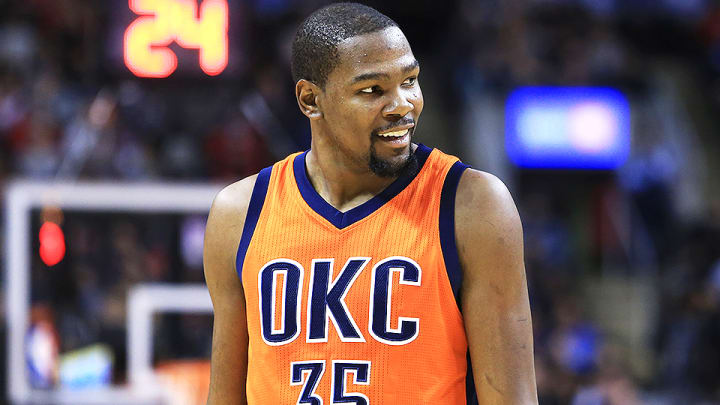
Your teams. Your favorite writers. Wherever you want them. Personalize SI with our new App. Install on iOS or Android.
No matter where Kevin Durant plays next season, the free agent will be paid extremely well: Durant will earn approximately $26 million as part of a maximum NBA contract. If Durant, the league’s Most Valuable Player two years ago, remains with the Oklahoma City Thunder, he would maximize his wages. Under the so-called “Larry Bird exception,” which allows teams to sign their own free agents for more money than other teams, Durant’s contract with the Thunder would increase in value by 7.5% each year. If Durant instead signs with another team, his contract would annually increase in value by only 4.5%. Regardless of the team he plays for, Durant will also earn substantial income from the 10-year, $300 million contract he signed with Nike in 2014.
Lurking in the background of these numbers is the powerful role of state income taxes. Durant’s after-tax, take-home pay will vary based on to what extent his earnings are subject to state income taxes. If Durant seeks to maximize his take-home pay, state tax differences could position the Miami Heat and San Antonio Spurs as the leading franchises to secure his services.
Durant has reportedly scheduled meetings with six teams: the Heat, Spurs, Oklahoma City Thunder, Boston Celtics, Los Angeles Clippers and Golden State Warriors. These teams play in states with very different tax laws. The Heat and Spurs play in two states—Florida and Texas, respectively—that do not impose a state income tax. The Celtics, in contrast, play in Massachusetts, which imposes a 5.1% state income tax, while the Thunder play in Oklahoma, where the highest earning citizens are taxed at 5.25%. The Clippers and Warriors play in the most heavily taxed state, California, where Durant’s salary would be subject to a 13.3% tax rate.
•Anything is possible for Kevin Durant | KD’s free agency, explained
The extent to which Durant would be subject to state income taxes would depend on which state Durant resides. With the massive increase in NBA television revenue and corresponding increase in the salary cap, the disparity in state income taxes is larger than ever.
How Durant’s take-home pay is impacted by state taxes
To see the impact of state income tax differences on Durant’s take-home pay, we break down how much money Durant would actually “take home” by signing max deals with each of the six teams. Note that the NBA’s collective bargaining agreement permits Durant to sign a four-year deal with five of those franchises and a five-year deal with his current team, the Thunder.
We make six key assumptions. First, and most meaningfully, we assume that Durant will sign the longest contract possible. Durant could instead sign a shorter-term contract, such as by resigning with the Thunder for one-year with a player option. He could then sign a long-term max contract in 2017, when a max contract would be expected to be of higher value. Under the NBA’s current collective bargaining agreement with the NBPA, maximum salaries for players with Durant’s nine years of service are based on the higher of 30% of the salary cap or 105% of his salary in the last year of his contract. After the 2016–17 season, however, Durant would have accrued 10 years of service and would be able to sign a more lucrative max contract—the value would based on the higher of 35% of the salary cap or 105% of his salary in 2016–17.
• SI’s top 50 free agents available | Finding perfect fits for 10 free agents
There is some risk for Durant in waiting till July 2017 to sign a max contract. For one, the NBA and NBPA have until Dec. 15 to provide notice of intent to opt out of the existing CBA. The two sides would then attempt to negotiate a new CBA. It is unclear how a new CBA might impact the calculus of max contracts. In addition, Durant could suffer a significant injury during the 2016–17 season and no longer be positioned to earn more as a free agent. For purposes of our chart, we assume that Durant will sign a long-term deal now and enjoy the security of knowing the money is fully guaranteed.
As a second assumption, we assume Durant will reside in the state where his team plays. Players normally reside in the states where they play, but Durant would not be obligated to do so. Third, we deduct the standard 4% agent commission from his NBA contract. Fourth, we assume Durant earns $30 million a year from his 10-year, $300 million endorsement deal with Nike. Fifth, for purposes of this illustration, we decline to guess what his agent commission would be on his Nike deal. We are only using earnings from his NBA contract and Nike deal.
Without further adieu, our data:
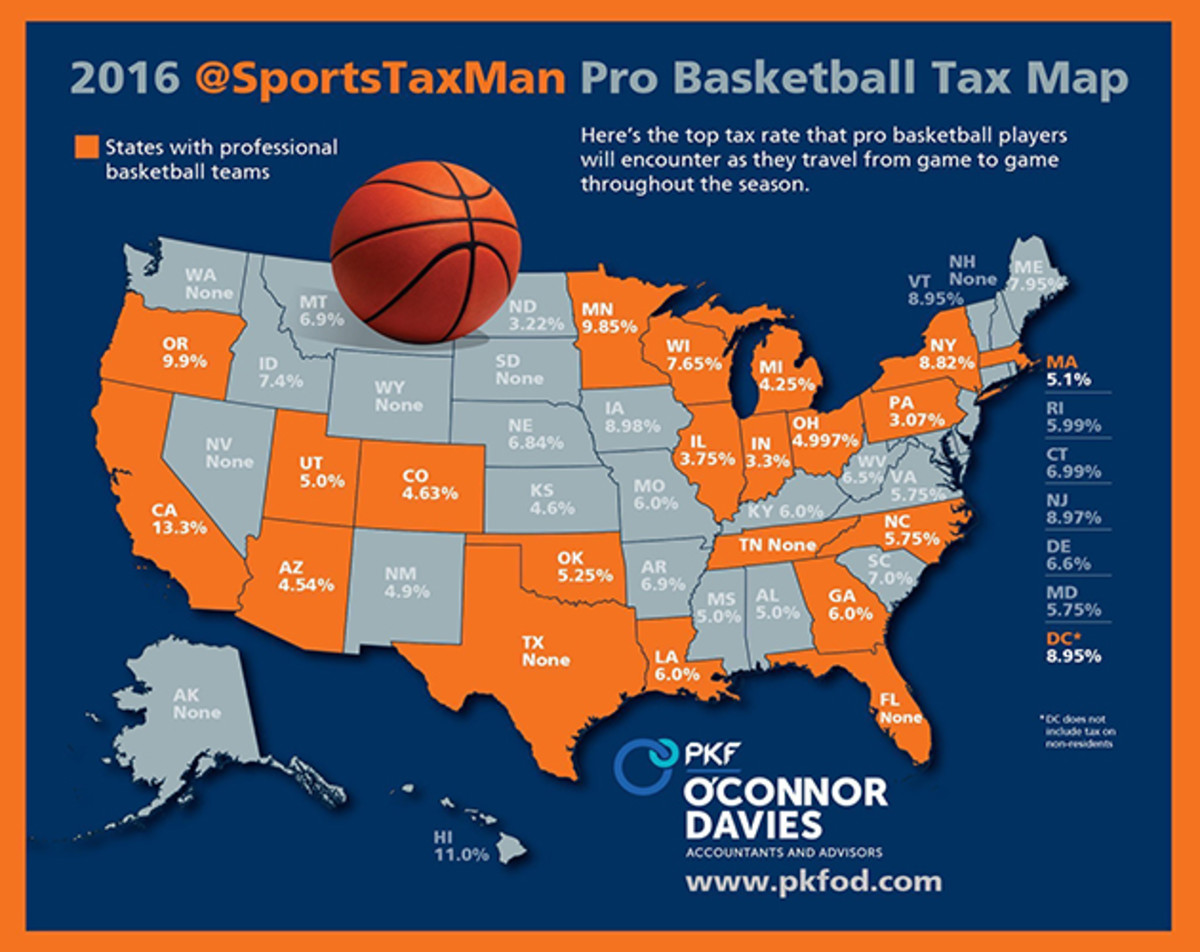




These charts reveal that Durant, over the next four years, could earn $18.3 million more playing for the Heat or Spurs than he would playing for the Warriors or Clippers. This is true even though his wages would be the same on all four teams. During that same four-year deal, Durant could also earn $13.9 million more playing for the Thunder than he would playing for either of the Californian teams, plus be certain to receive an additional $33.5 million from the Thunder in wages during the 2020–21 season.
The disparity in take-home pay for max players is nothing new in the NBA. We highlighted this issue when Carmelo Anthony and LeBron James were set to become free agents in 2014.
Differences in state income taxes are of course not the only distinguishing characteristics of these six teams. Each has certain qualities that likely attract Durant. The Thunder, for instance, have been Durant’s team since the start of his NBA career and he could sign with them for a fifth year. The Celtics have a very promising future and could sign Durant and another NBA star—perhaps Al Horford, whom Durant would reportedly like to play with—to max contracts. The Clippers and Heat are playoff teams in locales that may be of particular interest to Durant. The Spurs and Warriors are two of the best teams in the NBA. There are plenty of other distinctions, including cost of living (California, for example, is the fifth most expensive to live), proximity to family and culture. State income tax differences, in other words, are not the only issue. But they matter.
Kevin Durant leads SI’s top NBA free agents available
Top NBA Free Agents of 2016
1. Kevin Durant
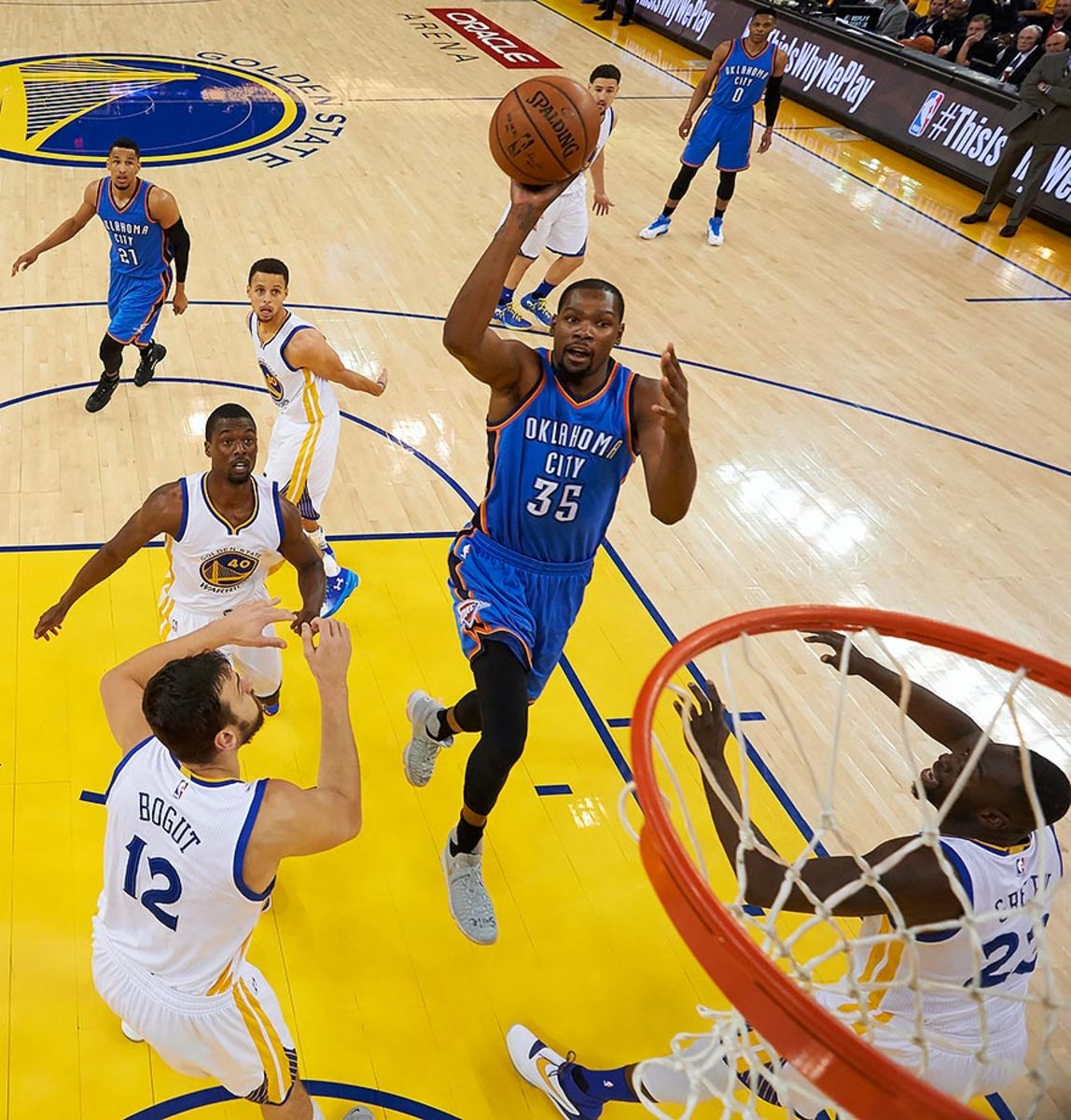
Durant is dominant at a position of relative scarcity, stellar as the centerpiece of an offense, flexible enough to augment his teammates, better on the boards than most will ever know, perfect in a role as the leader of a franchise, savvy off the dribble, efficient from all over the floor, ruthless to opponents while agreeable to teammates, and perhaps the most lethal small-ball player in a league that increasingly leans toward speed. Durant holds in his hand the power to reshape the future of multiple franchises. The Oklahoma City Thunder, who have more to lose with his decision than any other team, will wait breathlessly while KD deliberates between max offers.
2. LeBron James (player option)
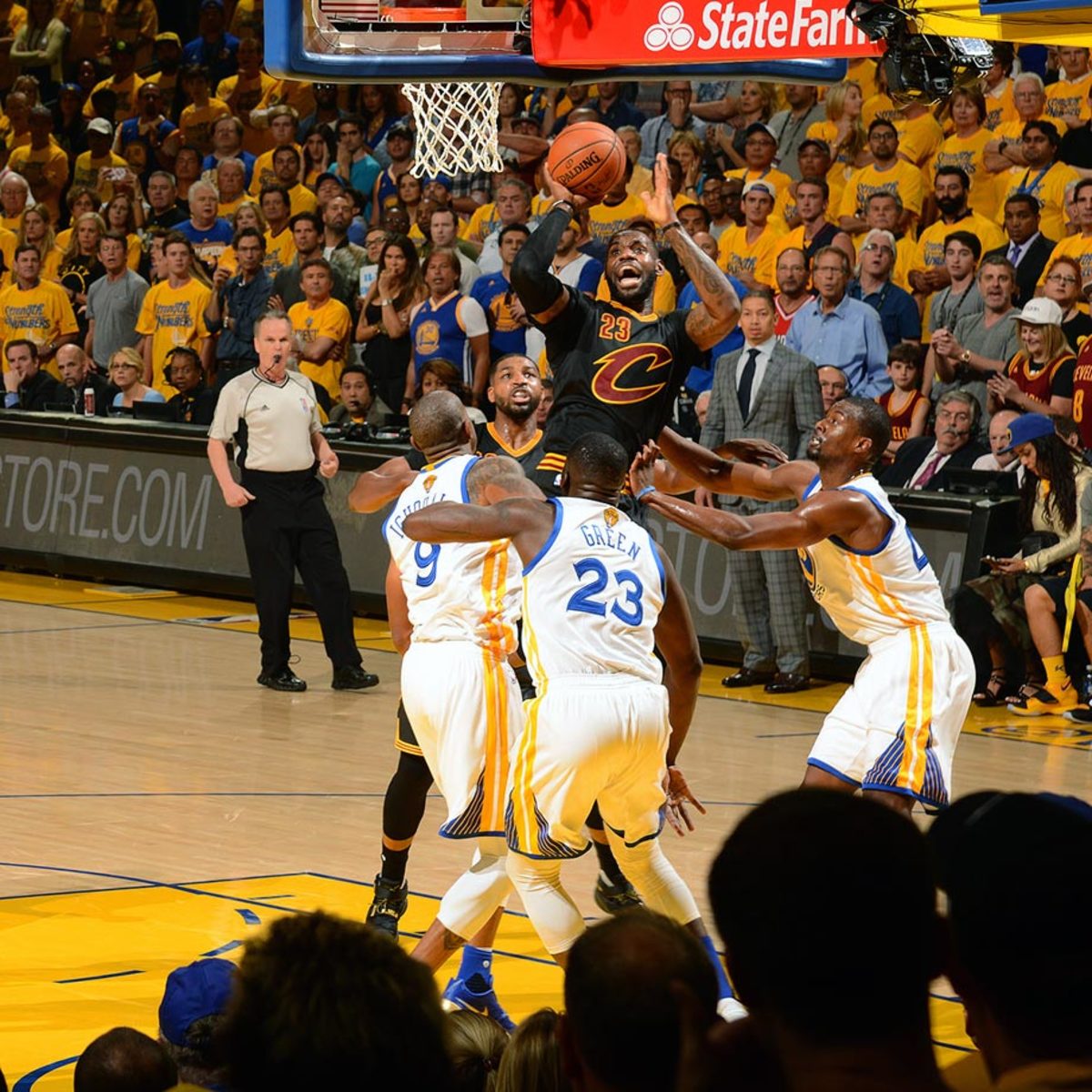
A word to teams around the league: Were LeBron actually available, you’d know. He hand-picked the Heat, let the Cavs know to clear room, and would surely call his own shot if there were any reason for him to leave Cleveland. There isn’t—so I wouldn’t wait up.
3. Andre Drummond (restricted)
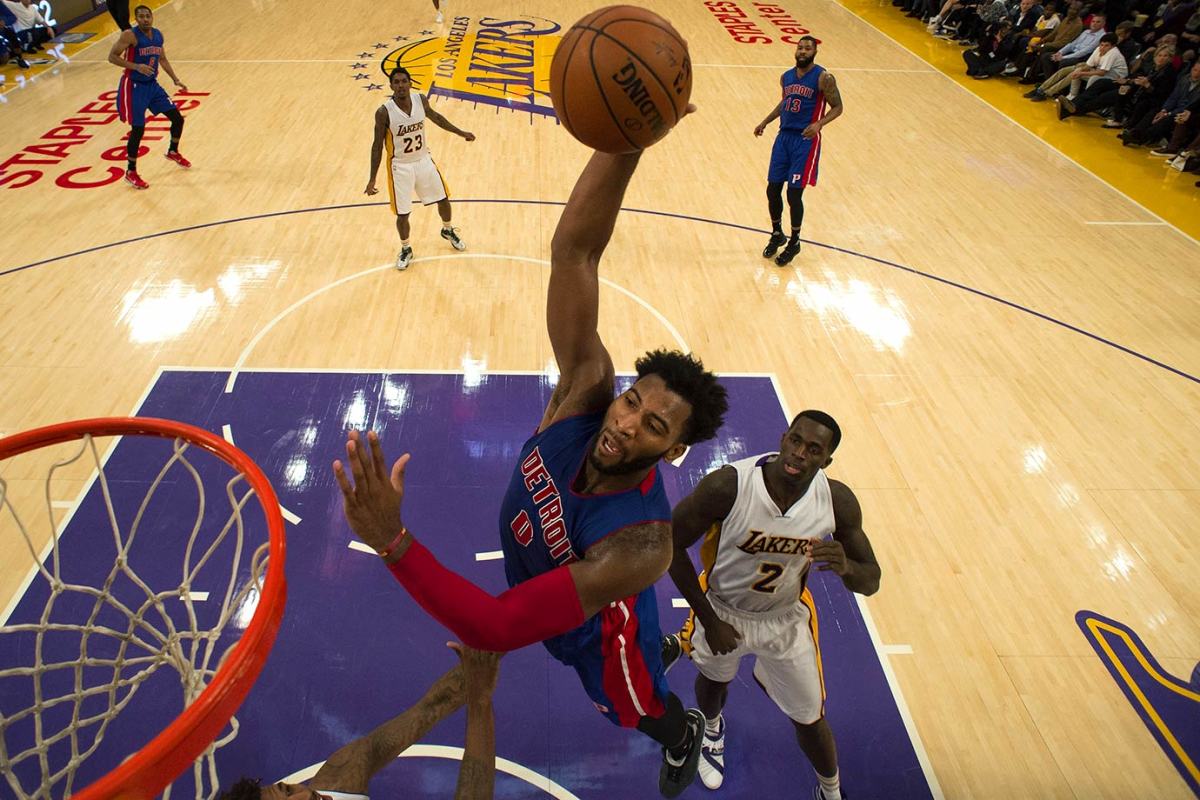
Restricted status should quell Drummond’s free agency from the start. Pistons owner Tom Gores is already on record as saying that Detroit will give Drummond the maximum allowed, leaving relatively little to negotiate. The Pistons will match any offer Drummond signs (should he opt for a shorter deal, for example) but otherwise seem likely to agree to whatever their upstart center wants. You don’t mess around with wildly productive, 22-year-old bigs—even those with a lot left to learn.
4. Al Horford
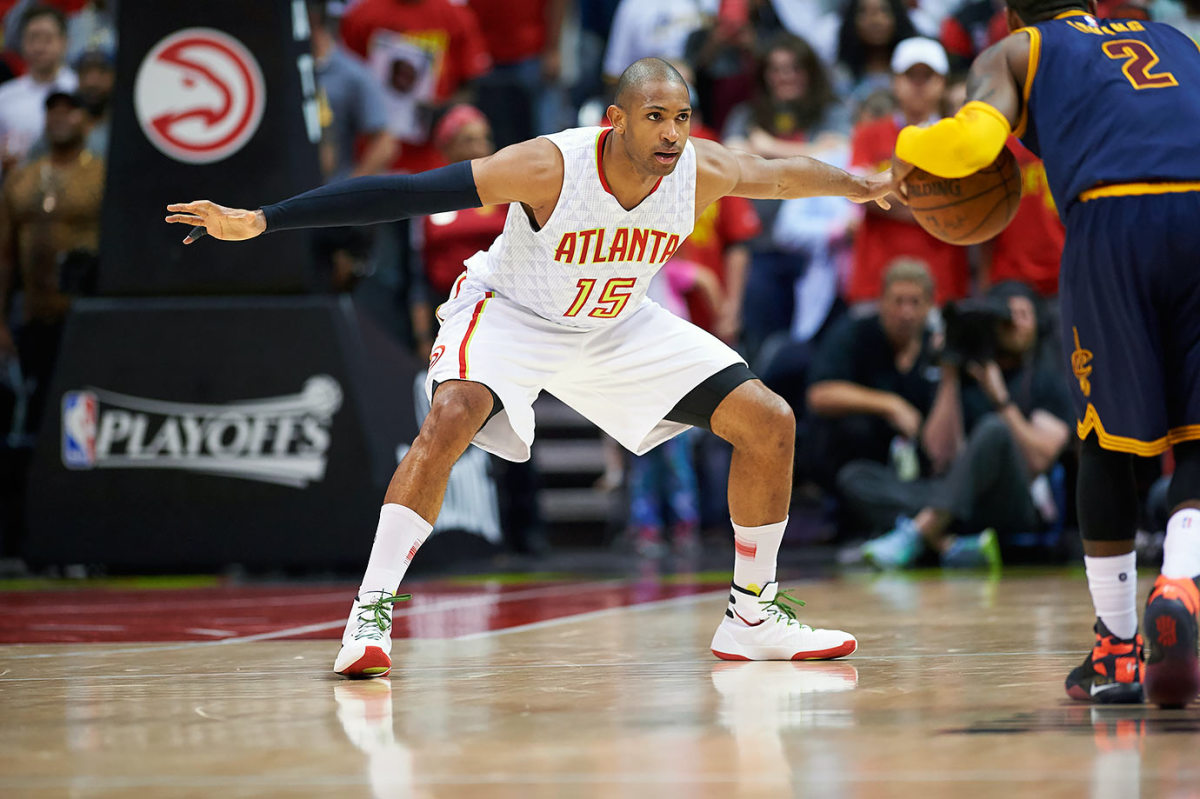
A player of considerable understatement. Watch the Hawks on occasion and you may gloss over Horford’s subtle defensive positioning, heady passing and gravity on the perimeter. Tune in on a more regular basis and his influence becomes glaring. Some players are simply best appreciated in volume, when the whole of their contributions form more complete trends. It’s no mistake that most teammates seem to fare better when Horford is around; his skill set slides neatly into whatever a coach aims to run and complements players of all kinds. That in itself is rare and attractive. Never discount the value of a player who opens up the playbook and a world of lineup constructions rather than limit them, especially as a hyper-flexible big.
5. Mike Conley
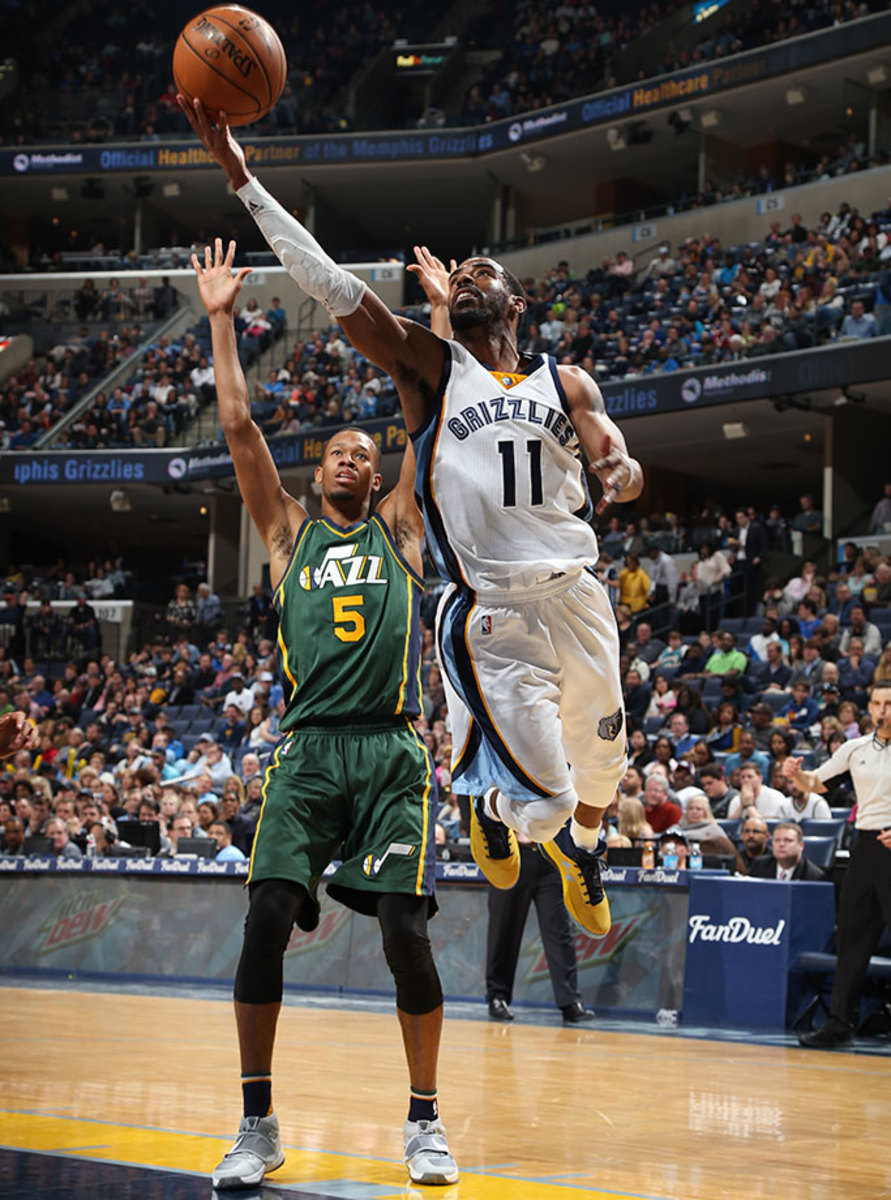
The best point guard on the market is also the only point guard of star-level consequence. Conley can satisfy a lot of needs—that for balance and composure, above all. Teams can play either fast or slow with Conley at the helm, while looking to attack from either inside or out. Unlike many ball handlers of his caliber, Conley actually adds to the operation of a team defense.The peril comes with scarcity. Angling for Conley’s services is a position of inherent risk given the alternatives. Once he makes his choice, a few teams will be left to parse middling backup plans or explore using their cap space more creatively. There’s a cost that comes with chasing any particular free agent, but the drop between Conley and his positional colleagues is the most precipitous of all.
6. Hassan Whiteside
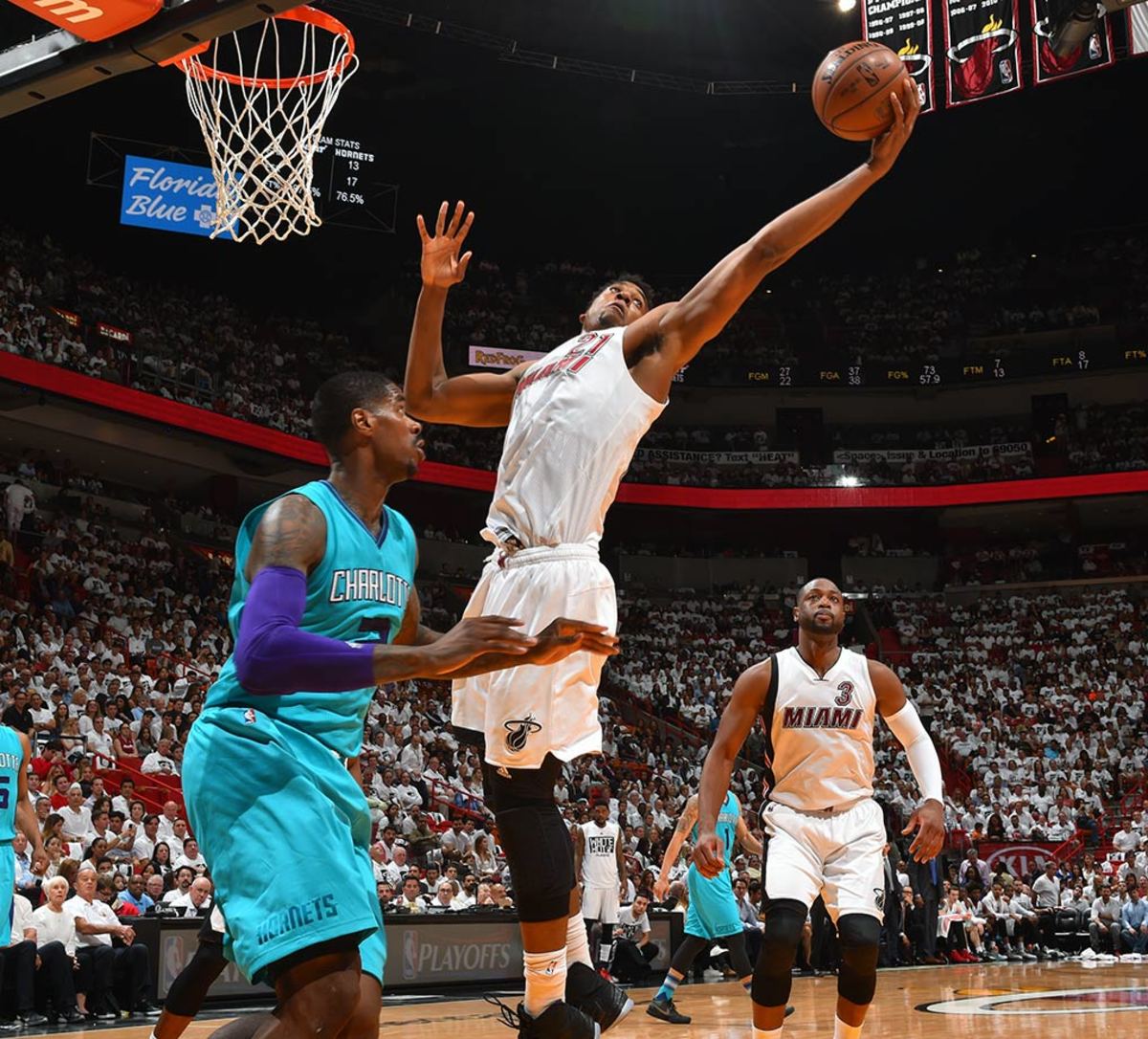
First, the irrefutable: Whichever team lands Whiteside will add one of the best shot-blockers, bulk rebounders, and alley-oop finishers in recent NBA history. Whiteside made himself into a max-contract player through a season and a half of considerable scrutiny and hard-earned production. One does not average 17.6 points, 14.7 rebounds, and 4.6 blocks per 36 minutes by accident. Nevertheless, there’s a disconnect between what Whiteside gives in terms of his raw counting stats and what he actually offers a team. His defensive presence, intimidating though it may be, is subject to Whiteside actually staying down on pump fakes and positioning himself to do more than chase blocks. Only Andre Drummond grabbed a higher percentage of available rebounds last season and yet Whiteside was guilty of letting his man run free rather than actually box him out.
7. Dwight Howard
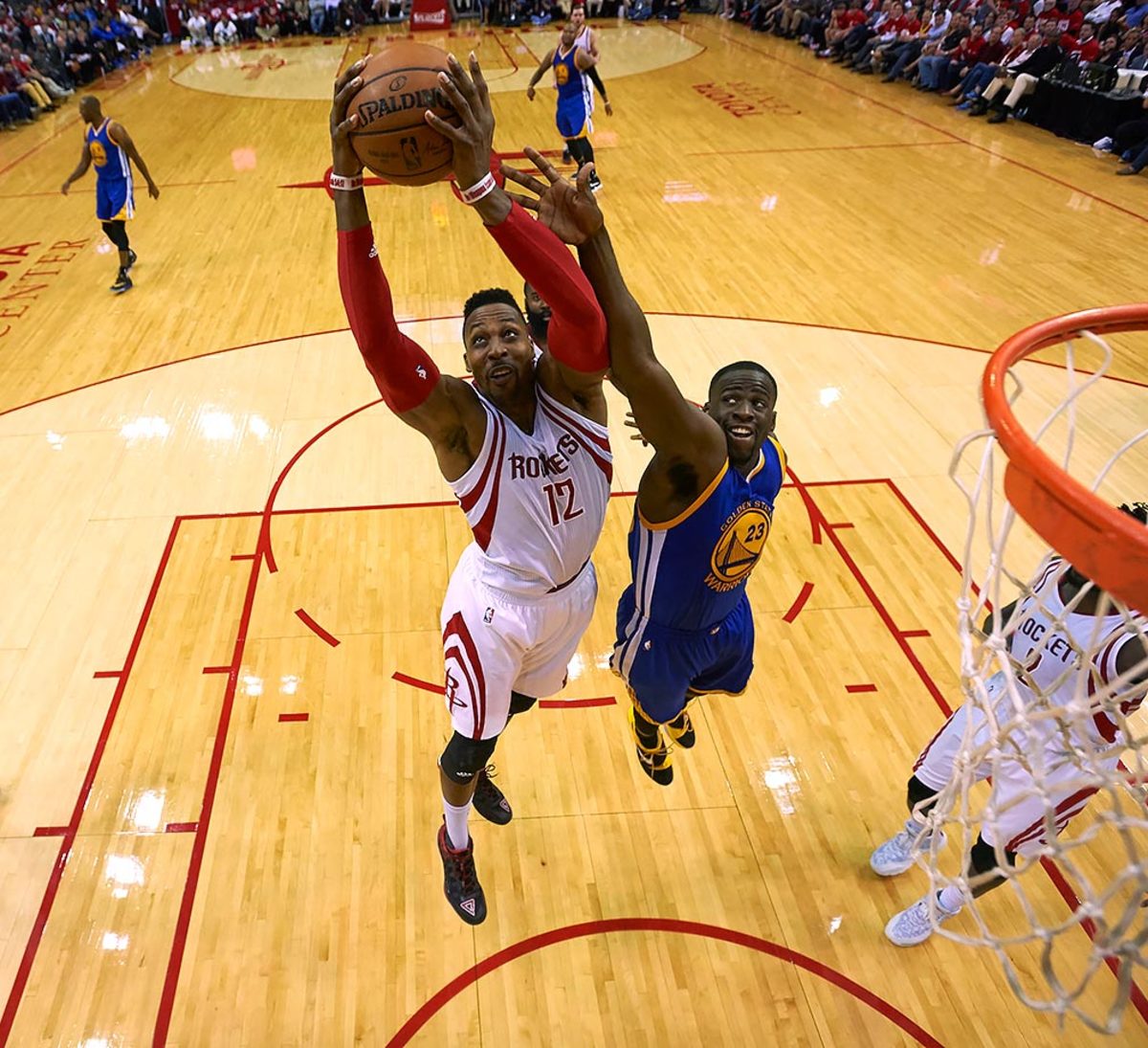
Injury and age have made Howard just another quality center. Gone is the Defensive Player of the Year frontrunner who, by his very presence, all but guaranteed a top-five defense. Departed, too, is the finisher who separated himself from the rest of the league with his nimble rolls to the rim and vertical explosion. Gone forever is the functional post scorer who could support an offense from the block, if not carry it comfortably. The Howard that remains has been muted by layering injuries and increasing age (30). It’s not always easy to appease him, but an involved and committed Howard is still worth the investment; the trick is finding the right offensive role as to make Howard feel essential without letting him hold the offense hostage for the sake of dead-end post-ups.
8. Bradley Beal (restricted)
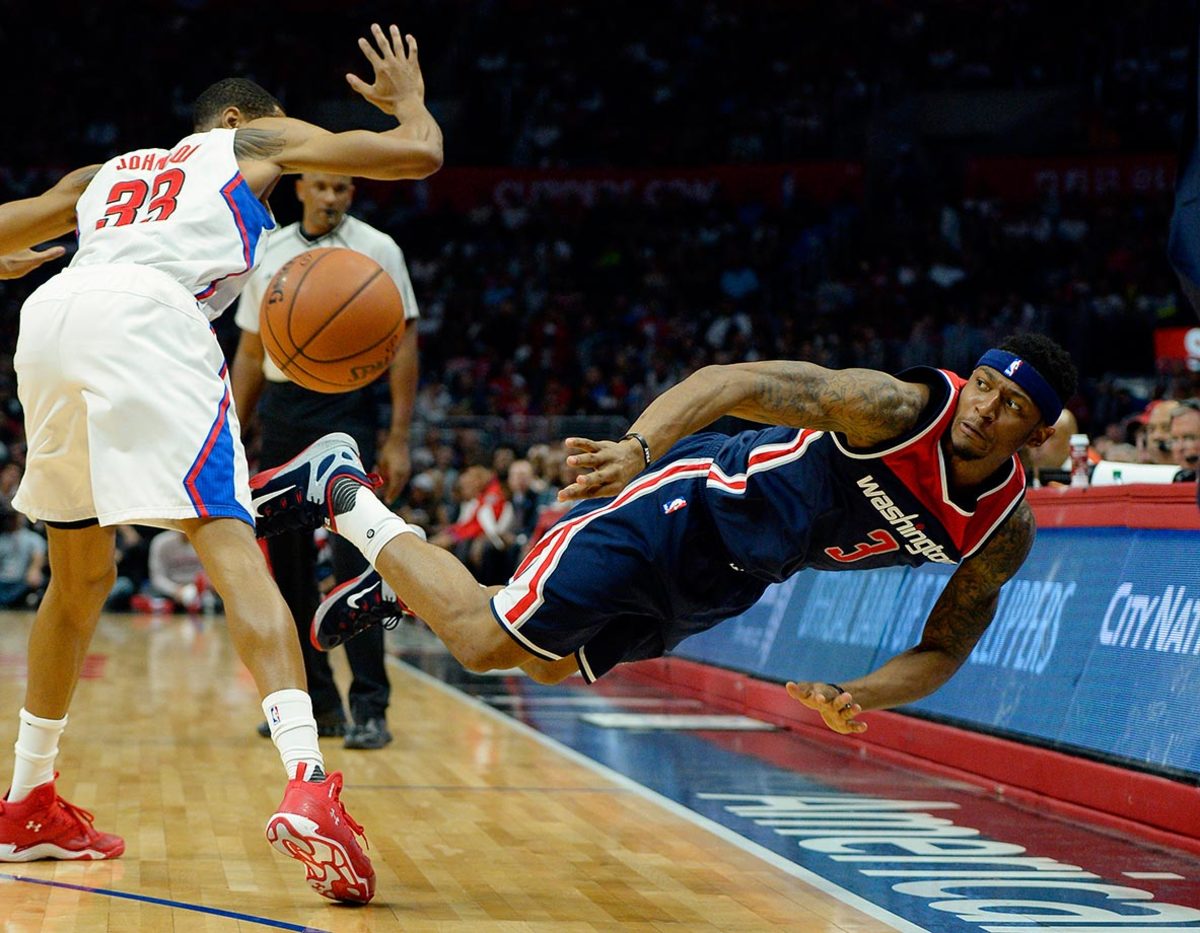
Beal, now four years into his NBA career, has yet to play a healthy season. On average he’s missed some 20 games a year, compromising the Wizards’ rotation for a quarter of their scheduled games. Still teams will line up to give Beal a huge contract because his game intrigues. The raw shooting ability, improving pick-and-roll work and competitive defense suggest max-contract credentials—even if Beal’s health has prevented him from assembling his complete game. Depending on your perspective, Beal’s age (22) either quells or fuels concern: Is his impending prime all the more reason to invest now or should teams be wary of Beal’s consistent pattern of injury? The truth is likely somewhere between.
9. Nicolas Batum
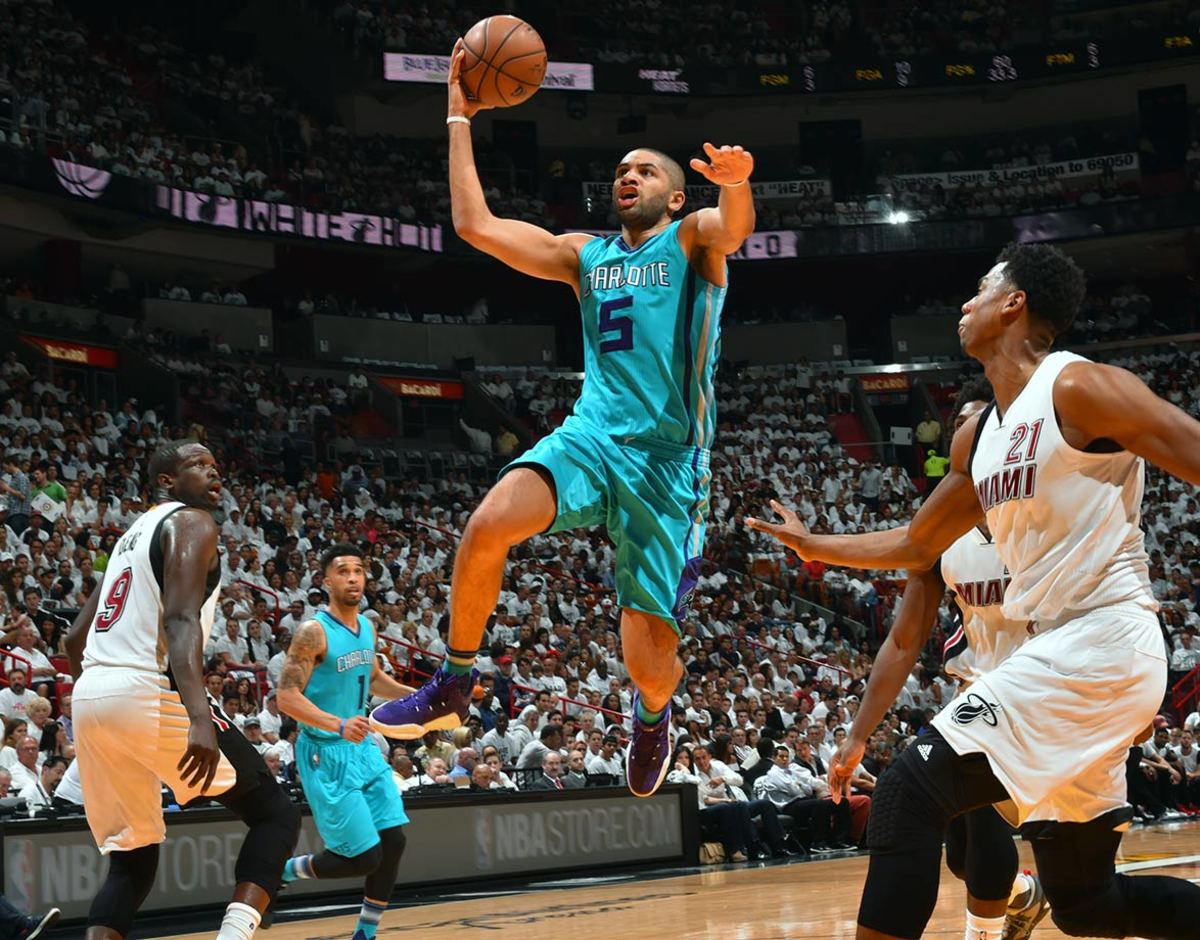
The Hornets dealt away a solid rotation wing (Gerald Henderson) and the No. 9 pick in the 2014 draft (Noah Vonleh) to acquire Batum last summer, confident that his versatile game could round out their playoff candidacy. Charlotte was so right it may now lose Batum to the open market. Signing the 27-year-old forward this summer will likely require the max or an offer close to it. Calibrate your market expectations accordingly. Batum brings smart secondary playmaking to go along with natural scoring, solid defense that builds off his impressive length, and a feel for offense that appeals to NBA coaches. That kind of multi-functional skill won’t be found in free agency this summer, save in the luxury tiers.
10. Dwyane Wade
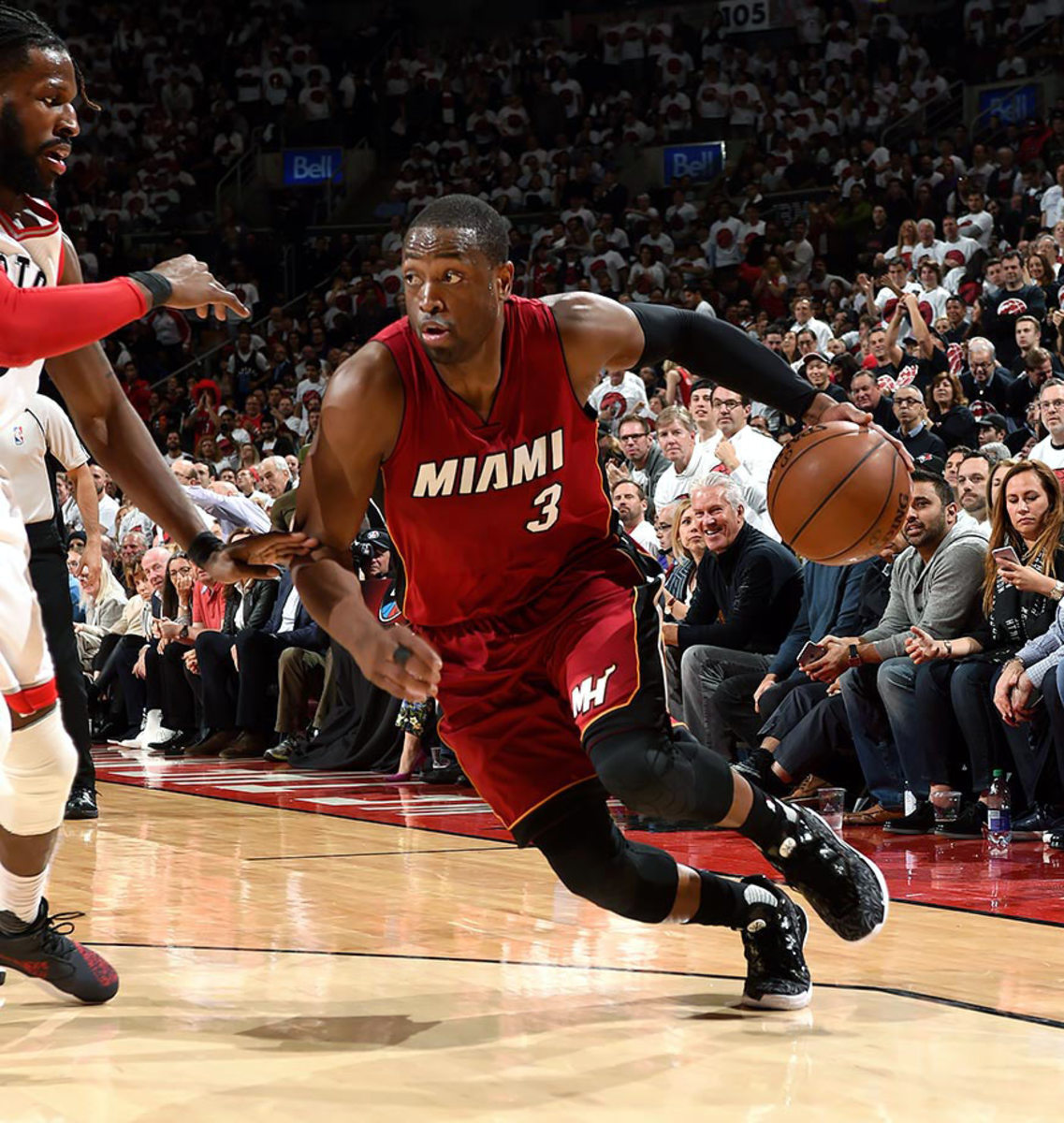
Every contract Wade signs for the remainder of his career will be a race against the clock. For now, the Heat stalwart generates offense at a level worthy of his Hall of Fame career. That could change at some point during the life of his next deal, even if it lasts a single season. Implicit risk must be priced in. Otherwise, suitors should expect familiar riffs on the same basic themes that have made Wade so effective for so long—all stemming from the clever manipulation of defenders. Even after 13 years in the league and three titles, Wade still dupes defenders with pump fakes and creates space where there should be none. That allows him to produce as is needed to outweigh his noncommittal defense and sagging efforts in transition.
11. DeMar DeRozan
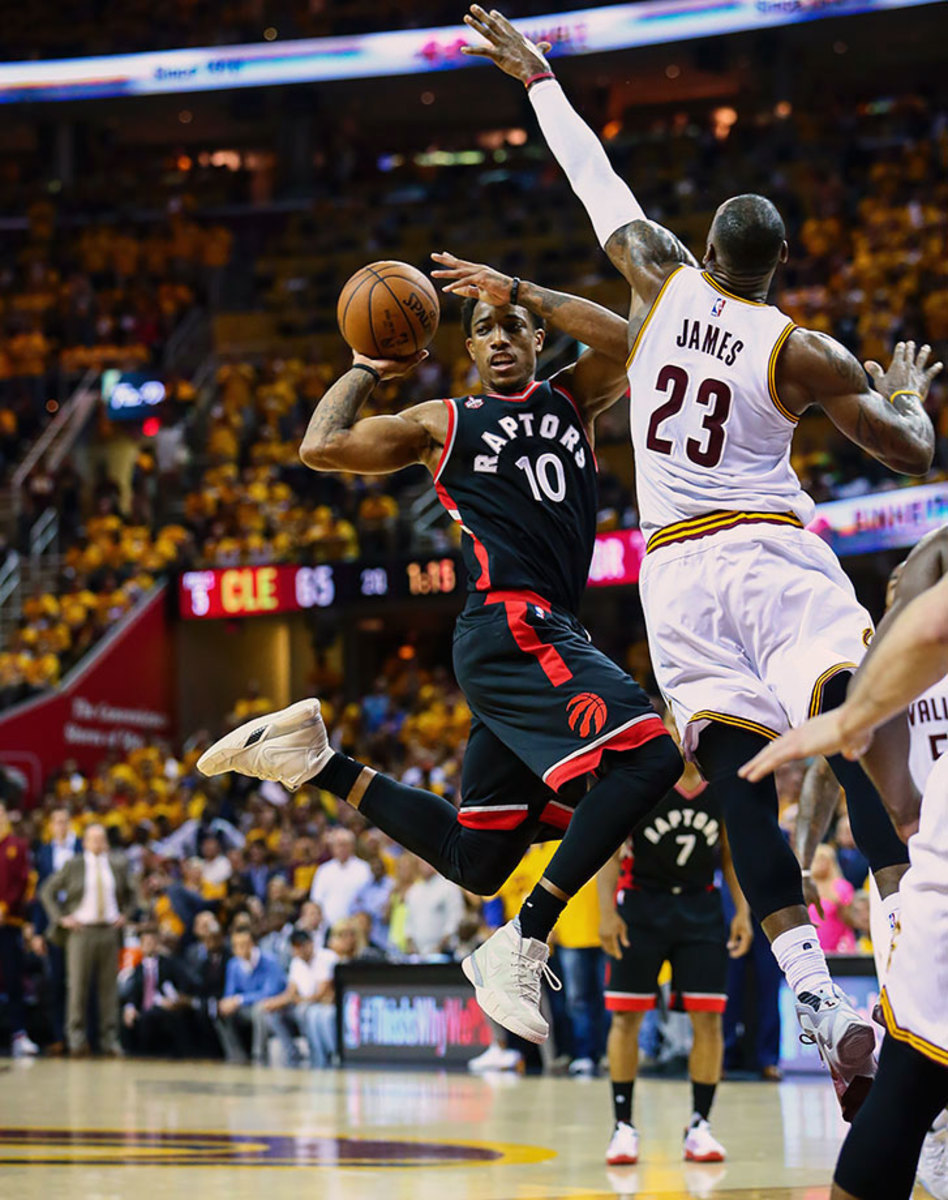
Every team’s mileage will vary with DeRozan given the particular boundaries of his game. Those desperate for scoring and lacking other means of offense would take his 23.5 points per game on 44.6% shooting from the field—much of it manufactured on his own—without much question. What DeRozan offers in that regard has clear value. It also, at a certain level of competition, is boxed in by limitation in a way that tends to create problems. To this point, DeRozan hasn’t shown all that much aptitude as a cutter or spot-up shooter (given his discomfort beyond the arc), which positions him to have the ball in his hands as a matter of necessity.
12. Tim Duncan (player option)
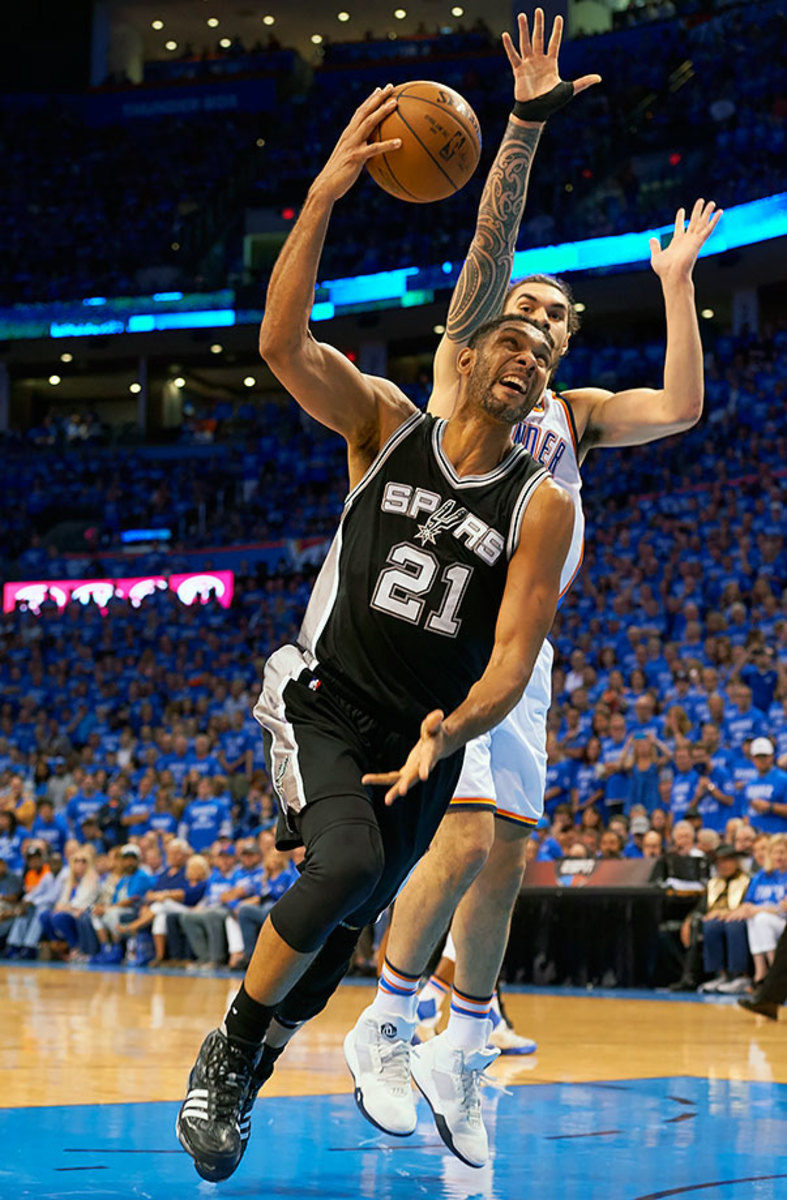
A potential free agent only in technicality. Duncan won’t be leaving San Antonio unless he leaves the league altogether.
13. Dirk Nowitzki
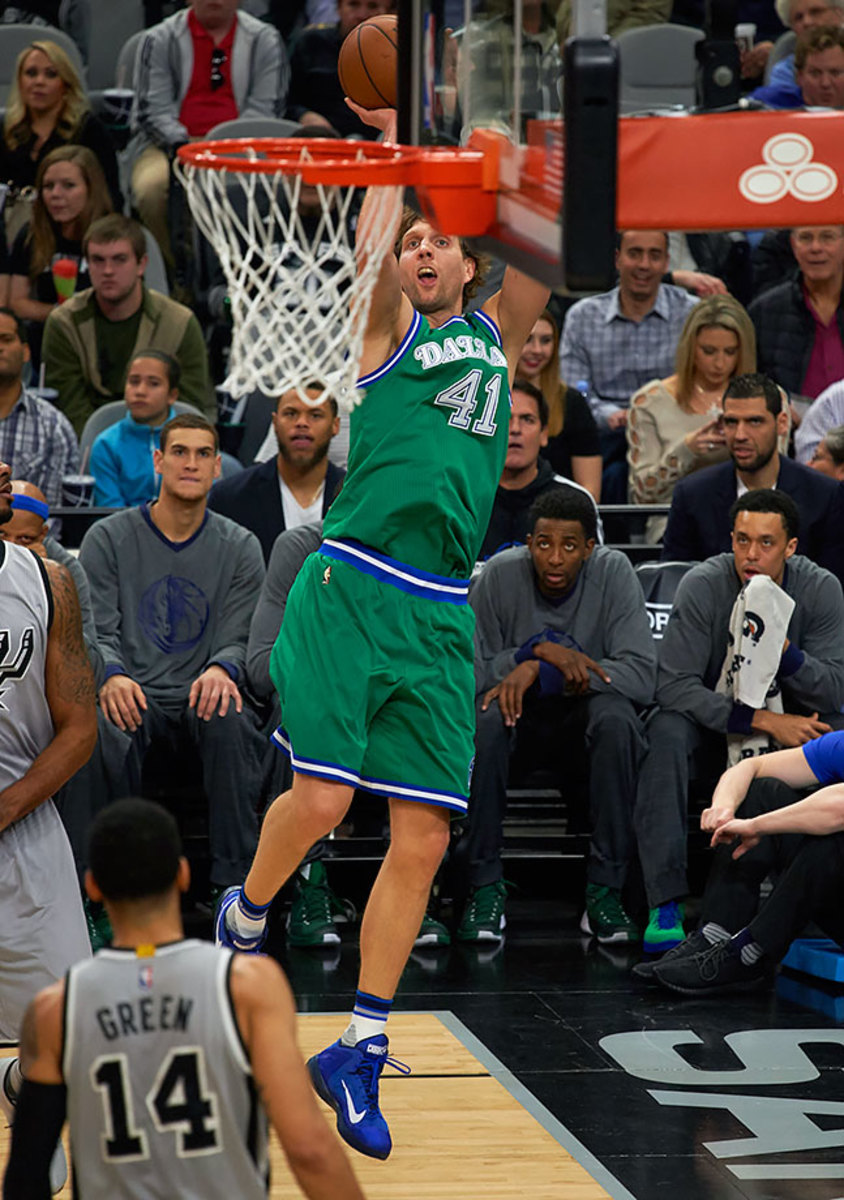
Athough Nowitzki has indicated that he has every intention to stay in Dallas, the fluidity of the Maverick roster leaves the matter open to reconsideration. Other teams will make their case. Nowitzki still delivers as both a shot creator and floor spacer, a dual capacity for offense that could aid many of the league’s contenders. It would be hard to blame Dirk if, in the midst of another reshuffle, he considers another offer and what could be. Still, it would take a special opportunity to budge Dirk from the city and franchise where he’s spent his entire career.
14. Chandler Parsons
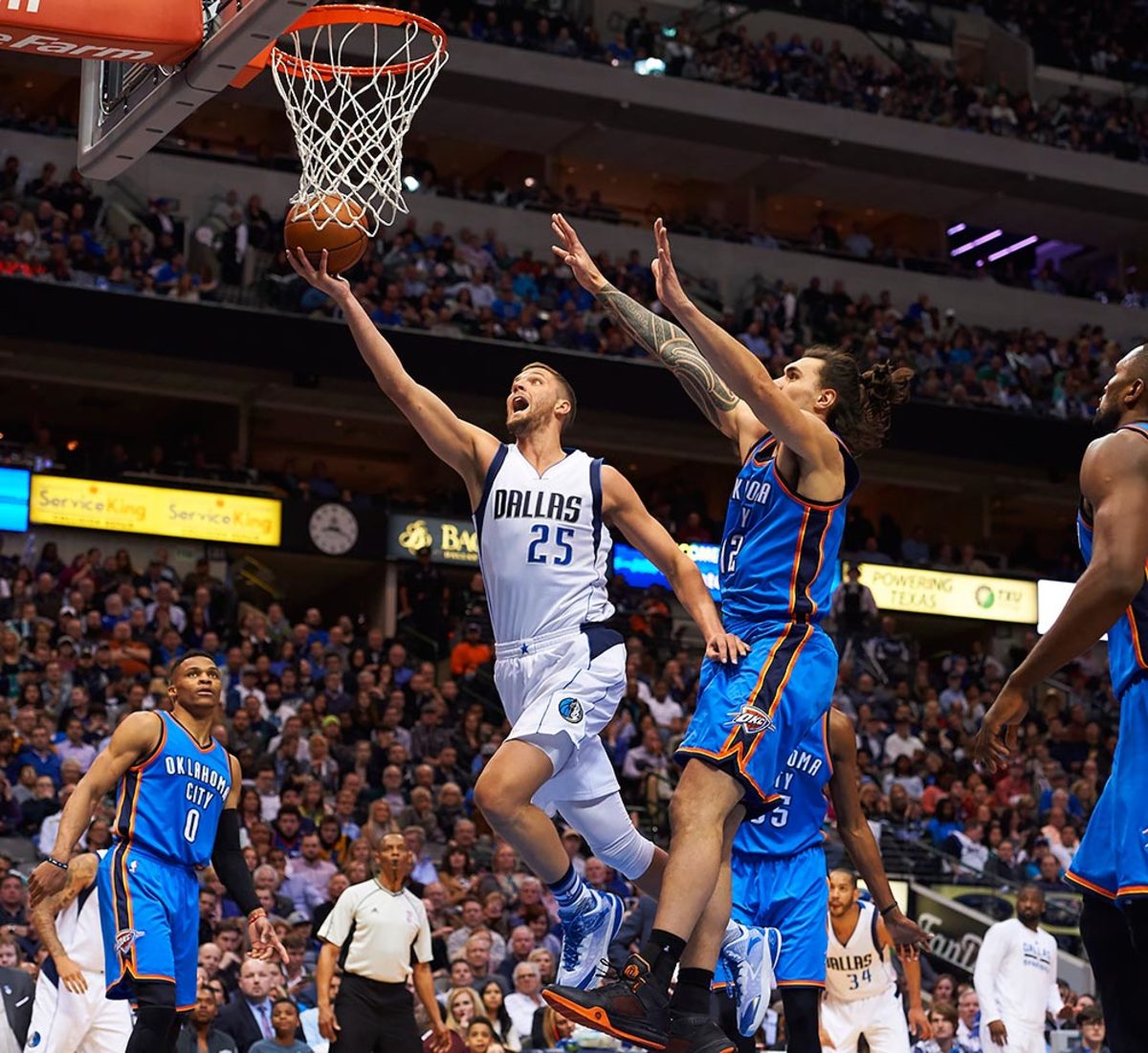
We still haven’t seen Parsons pushed to the full extent of his creative ability. This is a 6'9" forward who can run pick-and-roll more often than he’s been allowed, enable the athletic bigs on his team with lobs, and stutter-step his way into viable off-the-dribble offense. His knees are a legitimate hang-up; Parsons’s last two seasons with the Mavericks were each cut short by knee injuries and surgeries, first a hybrid microfracture procedure and then an arthroscopic procedure to repair his torn meniscus. The latter is decidedly less severe, though not without some cause for concern in Parsons’ broader injury history.
15. Pau Gasol
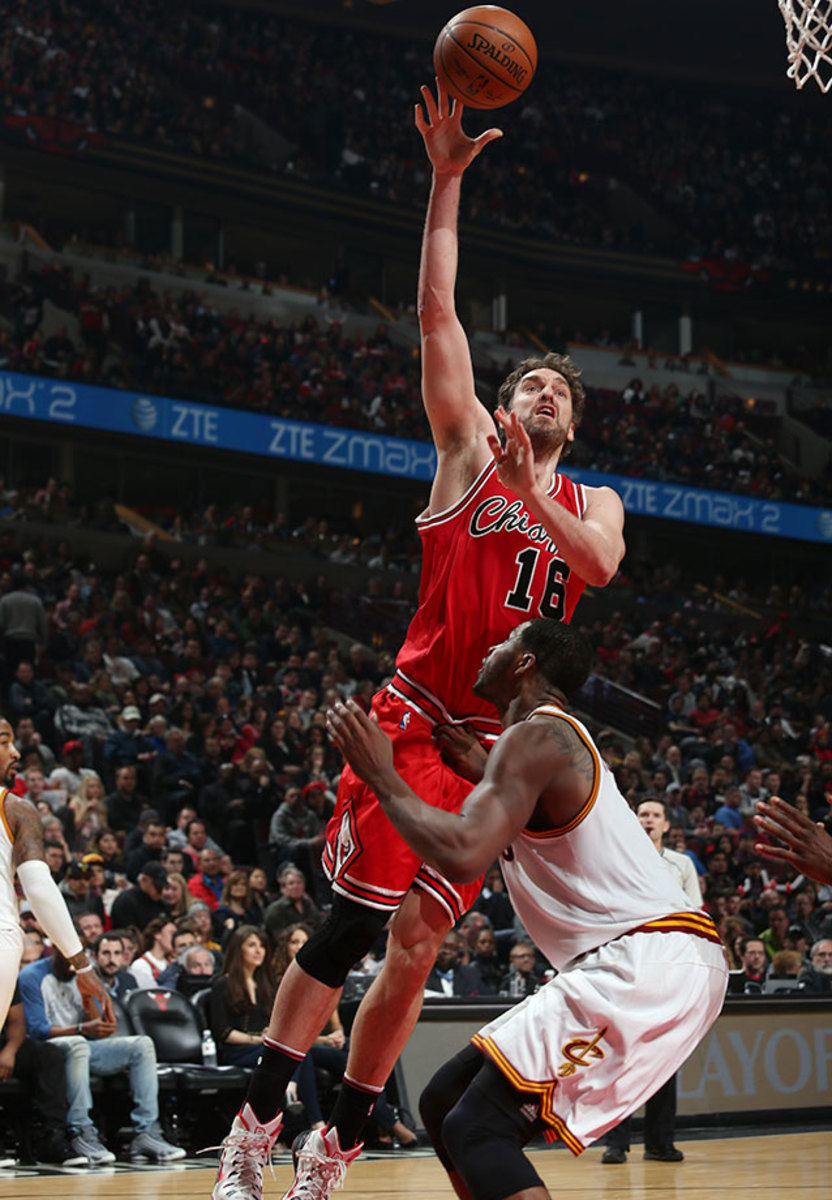
Gasol has earned the right to be particular. He wants to be involved in the basic operations of an offense and has the game, as a scorer and passer, to support the notion. Few can do what Gasol can, and virtually none in the history of the game have produced in the same way at his age (35). To this point, Gasol has expressed no interest in coming off the bench, even when it might serve his team’s best interests. Market matters to him because cultural life beyond the floor matters to him.
16. Bismack Biyombo
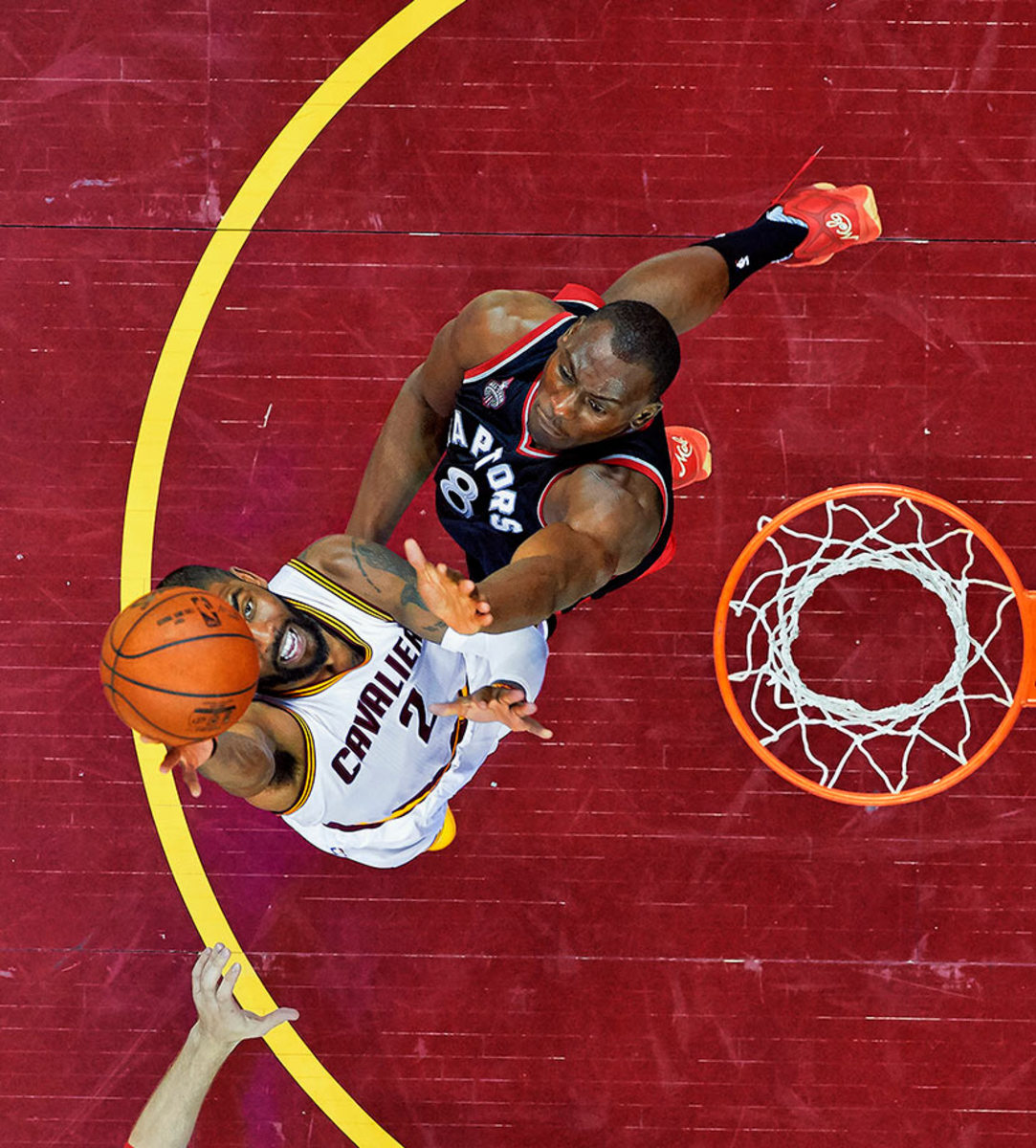
A productive scoring night for Biyombo might feature three or four field goals, all created by others, with minimal turnovers. There isn’t much to be gained by his play on that end, or even his planned involvement. Where Biyombo aids a team’s cause is in the physicality of the game elsewhere. Few bigs will chase rebounds so relentlessly, guard the rim so tenaciously, and set screens so forcefully. His energy alone extended Toronto’s postseason life, demonstrating in the process that even playoff teams might not have much answer for all he provides. Matchups that pull Biyombo away from the rim on defense can mitigate his value (exacerbating the fact that he’s already a one-way player), though none can subdue it completely. No viable player in this free agent class is so obviously limited and yet effective.
17. Ian Mahinmi
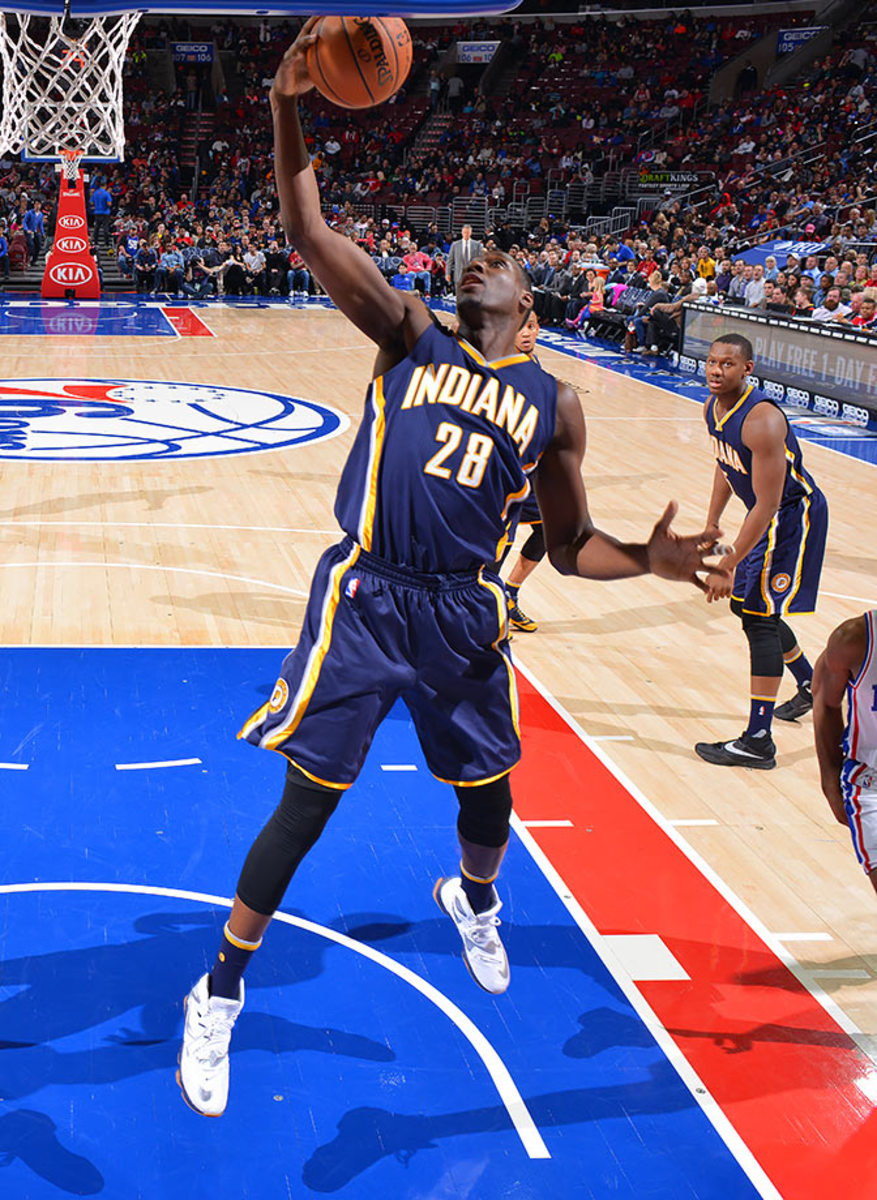
The arc of Ian Mahinmi is a nine-year journey from D-League-assigned project to starting-caliber center. Last season he provided the backbone of the third-best defense in the league while posting a double-double (13.1 points, 10.1 rebounds) per 36 minutes. The consistent foul trouble that once artificially curbed Mahinmi’s playing time has also been made manageable as he’s learned subtler ways of challenging shots and influencing opponents with a live dribble. All of that, coupled with a fascinating new poise in making decisions on the move, makes Mahinmi a prospective addition of impressive value. A team could do much worse than relying on Mahinmi to steady its defense and keep opponents honest in rotation for 30 minutes a night.
18. Festus Ezeli (restricted)
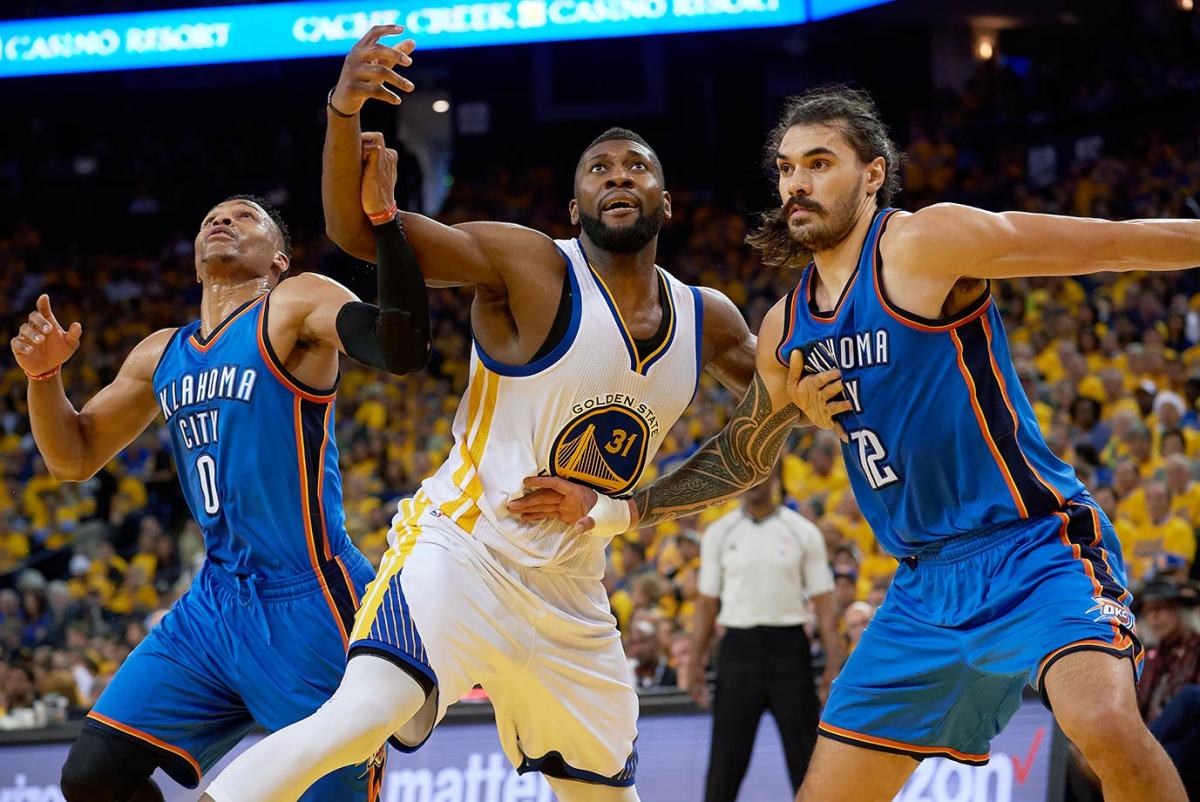
Ezeli’s time with the Warriors had run its course, as evidence by Steve Kerr’s uncommonly low tolerance for any of the center’s mistakes. To be fair, there are many; Ezeli can be an effective defender if not always the most technically sound, tends to see any touch within 15 feet as an invitation to attempt a hook shot, and can space out on his responsibilities on both ends at times. Even still he has the size and mobility to make a difference, particularly now that he’s able to actually catch the ball and make an occasional move in traffic. Ezeli might not always do what his coaches want him to, but he’s one of the few bigs available who can scurry out to the perimeter to contain a pick-and-roll, swat away shots at the rim, and hold his own against physical centers on the glass.
19. Ryan Anderson
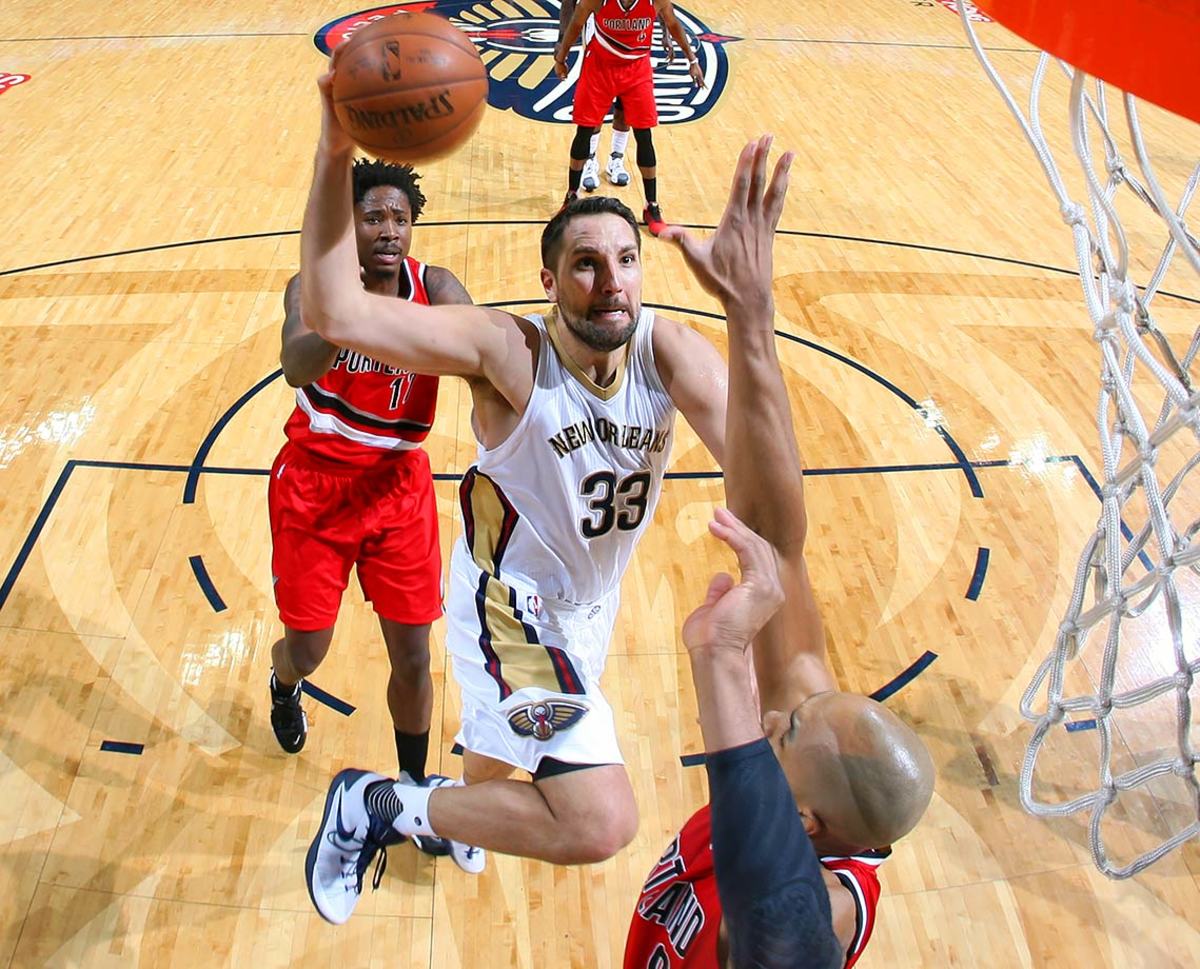
Shooters like Anderson demand respect, which in itself allows his teams to operate from a position of some advantage. Dedicating a defender to guard him closely can compromise an opponent’s rotations. Looking to contain him through a more straightforward system of help and recover will inevitably ask some frantic defender to run out to the three-point line to contest his high release. Anderson has proven he can hit those shots, though the rest of his game requires a team built to mask his flaws. Opponents have found success switching smaller defenders on to Anderson and lived with his forays into the post. Others have taken advantage of his lacking defense or used his matchup to attack the glass.
20. Marvin Williams
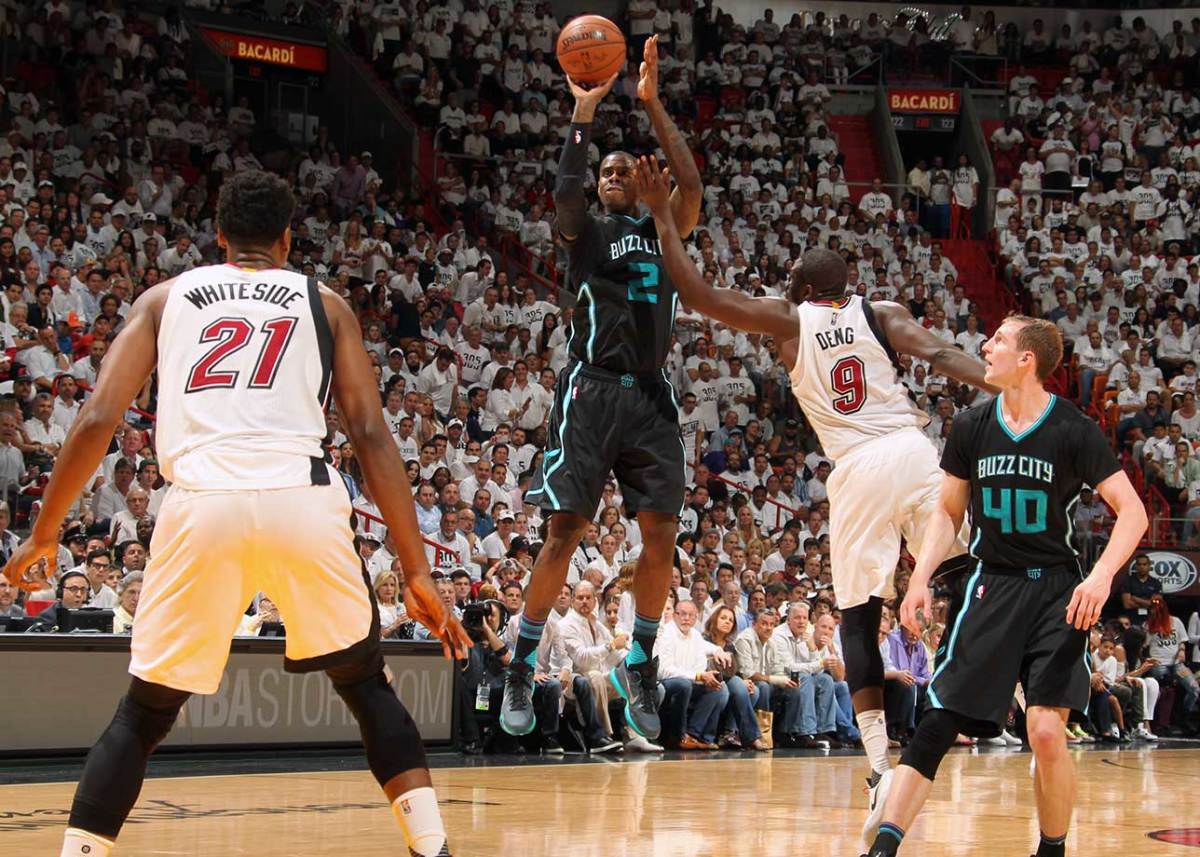
Over the course of two seasons, Williams remade himself into the player the Hornets needed: a flexible, stretchy forward who could punish opponents from the perimeter (40.2%), put the ball on the floor to attack a closeout, guard opponents at the three or the four, and offer reliable help in rotation. This is the profile of a high-impact player, even if Williams might not be known to many basketball fans outside of the unceremoniously quiet start to his career. Williams is a different player now, and one who stands to be rewarded handsomely for the utility he’s created for himself.
21. Al Jefferson
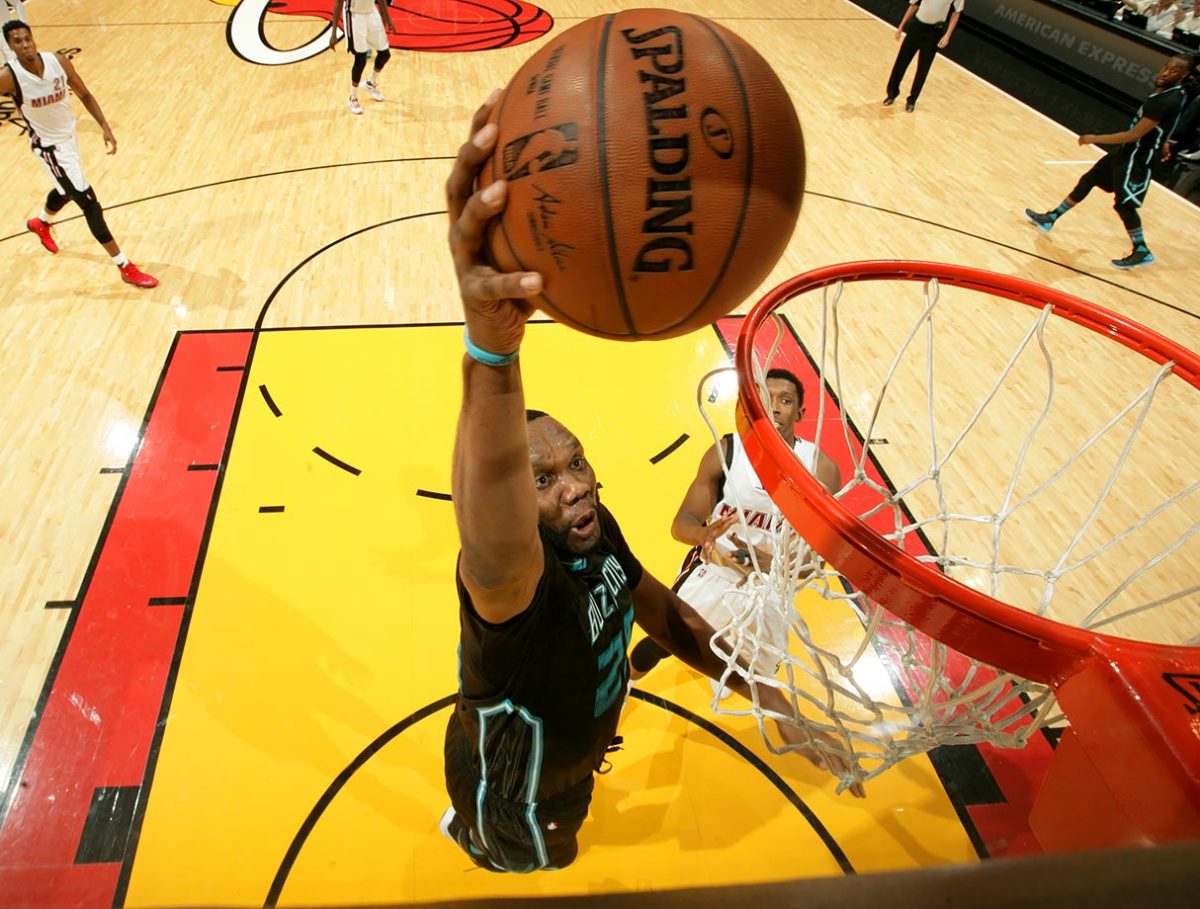
One of the best post scorers in the NBA will likely face a bearish market. Jefferson doesn’t much align with the vision of a modern NBA center. His offense requires possession of the ball but doesn’t generate much for others. The very nature of operating through the post makes an offense predictable and dependent on optimal spacing to reach even moderate efficiency. Defensively, Jefferson can survive when playing back and clogging up the lane but has no chance containing quicker players on the perimeter. Even as a rebounder Jefferson is merely solid—not at all a problem, but a few degrees removed from the statistical elite.
22. Harrison Barnes (restricted)
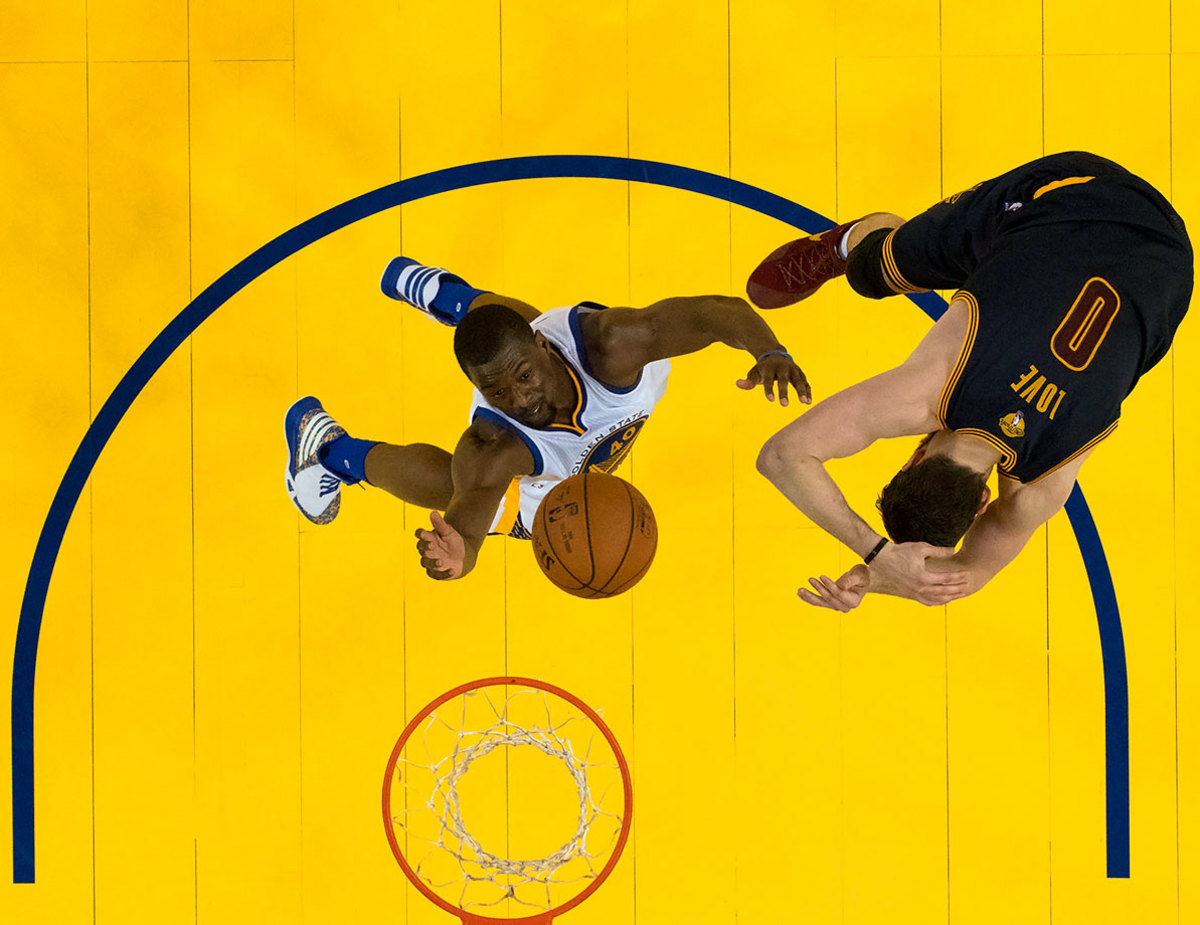
Dispense with the notion that Barnes is a star in waiting. His role with the Warriors is that for which he’s best equipped: walking the line between forward positions by stretching bigs out to the perimeter, posting up smaller wings, and guarding both effectively. There is no explosive potential lurking beneath the surface of a 24-year-old who struggles off the dribble. Barnes is who he is, and that player just so happened to key the 2015 title run and a near repeat in 2016.
23. Kent Bazemore
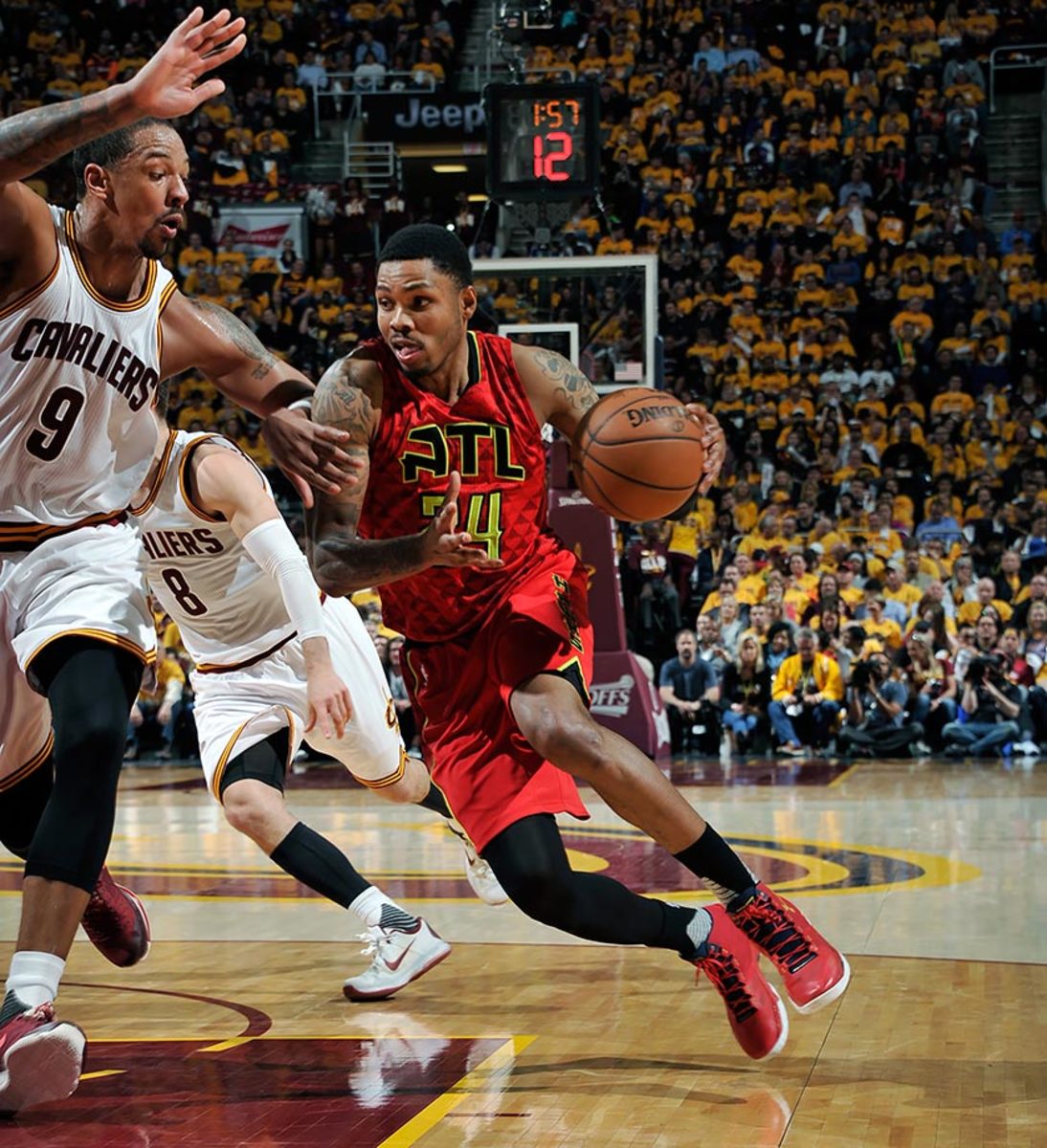
Atlanta cultivated Bazemore’s live-wire energy into a real, starting-caliber product. Many NBA teams could plug Bazemore into a complementary role and thrive with his bounce. Players who cut in bursts like he does and explode out into transition tend to catch a defense off-guard. Quickness and length allow him to cover ground more quickly than most opponents are accustomed to, even if Bazemore himself can sometimes space on his defensive fundamentals. Everything he does comes from an intersection of pep and discipline. Mike Budenholzer and his staff did all they could to rein in Bazemore without taking away the zip that makes him effective. They succeeded to the point that Bazemore became one of the most improved players in the league.
24. Evan Fournier (restricted)
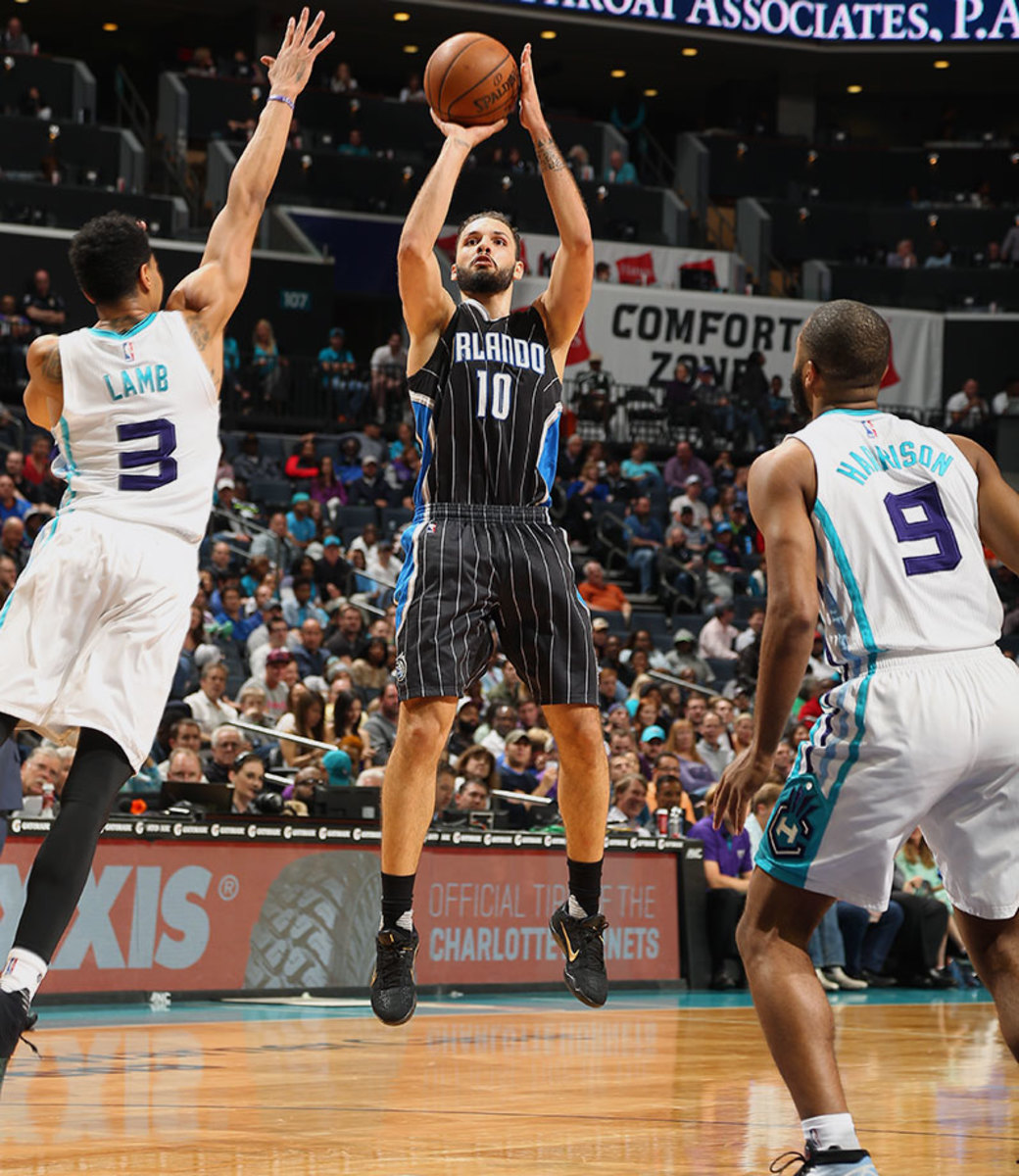
The league-wide need for quality wings could benefit players like Fournier most of all. Fournier can play. Putting the ball in his hands can spell an offense for minutes at a time, whether asked to create off the bounce himself or play off of his teammates. There’s a gutsiness to the way Fournier creates under pressure that bodes well for his performance in more competitive environments. That alone will make him an attractive free agent—as will a consistent three-point stroke that allows him to slide into a starting lineup alongside other high-quality players.
25. J.R. Smith
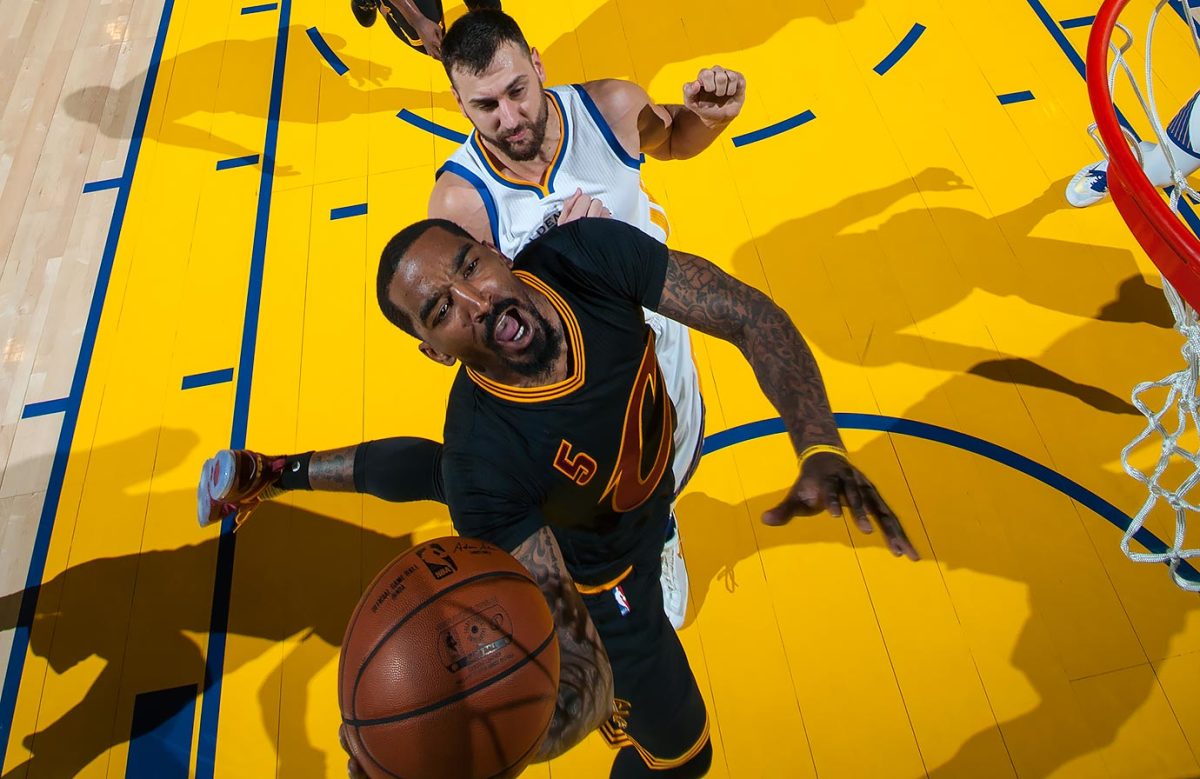
Make that ’NBA Champion J.R. Smith.’ Cleveland has the inside track on signing Smith after making better, more controlled use of his talents than any team had previously. Any other contender that can make a similar pitch should do so; the headaches that arise from employing Smith can be justified by his hot streaks. A single 8–0 scoring from Smith in Game 7 of the NBA Finals may well have determined the NBA champion. His 20 points in Game 3 were a bellwether. It’s a great help to have an All-NBA caliber shooter around who can launch smooth jumpers no matter if his footing is perfect or the pass lands in his shooting pocket. Smith can be streaky, but there’s no replacement for those who can return points—especially three-pointers—from a suboptimal setup.
26. Courtney Lee
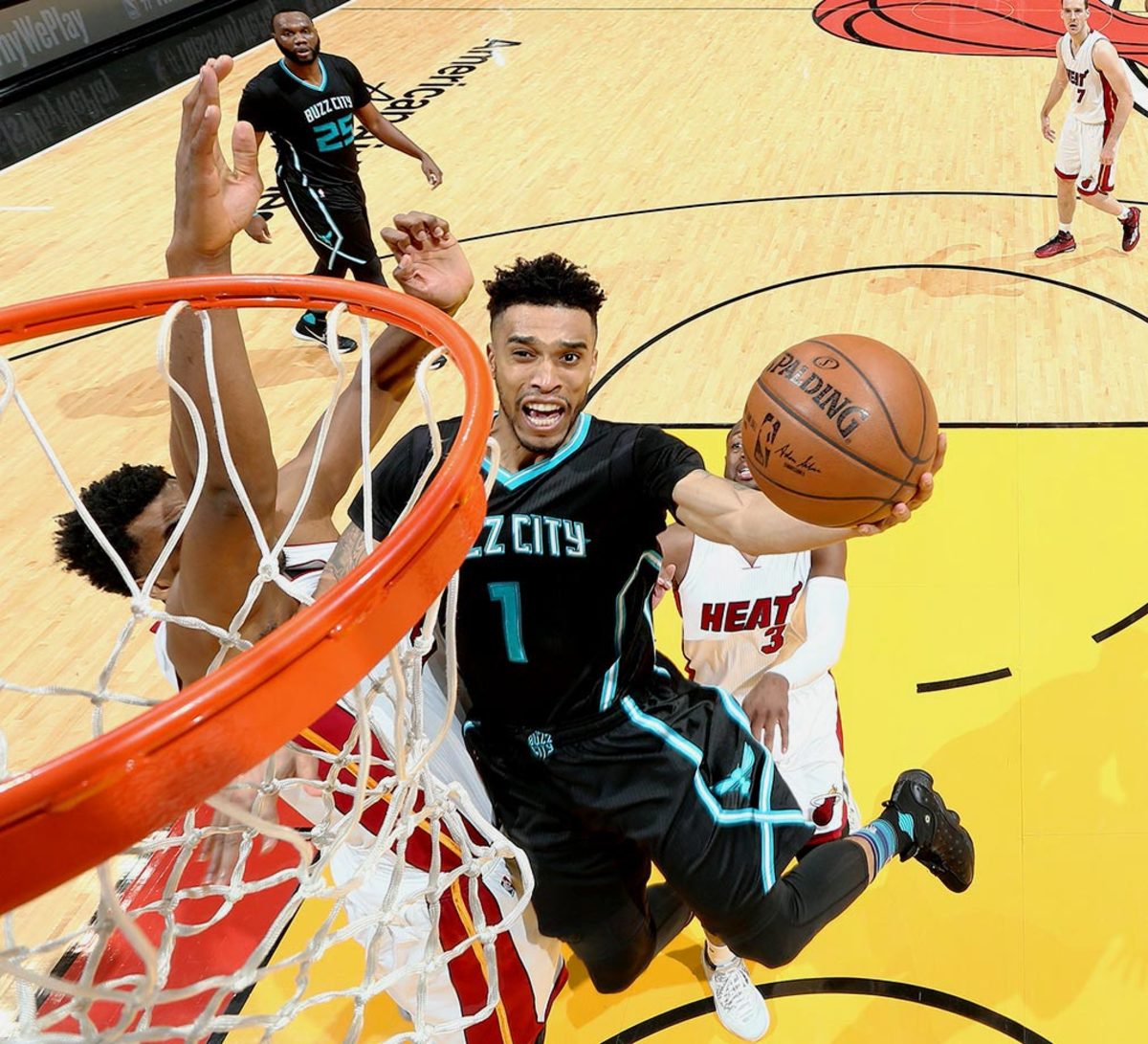
There may be no more important quality for an NBA role player than understanding where to be on the floor. Lee, 31, grasps the concept beautifully. Only a handful of players better time their cuts, and few among them will also glide around the arc to present as a shooting threat. Lee might come to the ball if his teammate is in a pinch or dart backdoor if the defense grows too eager. His defense is assertive—particularly against opposing ball handlers—but rarely puts his teammates in a bad spot.
27. Jordan Clarkson (restricted)
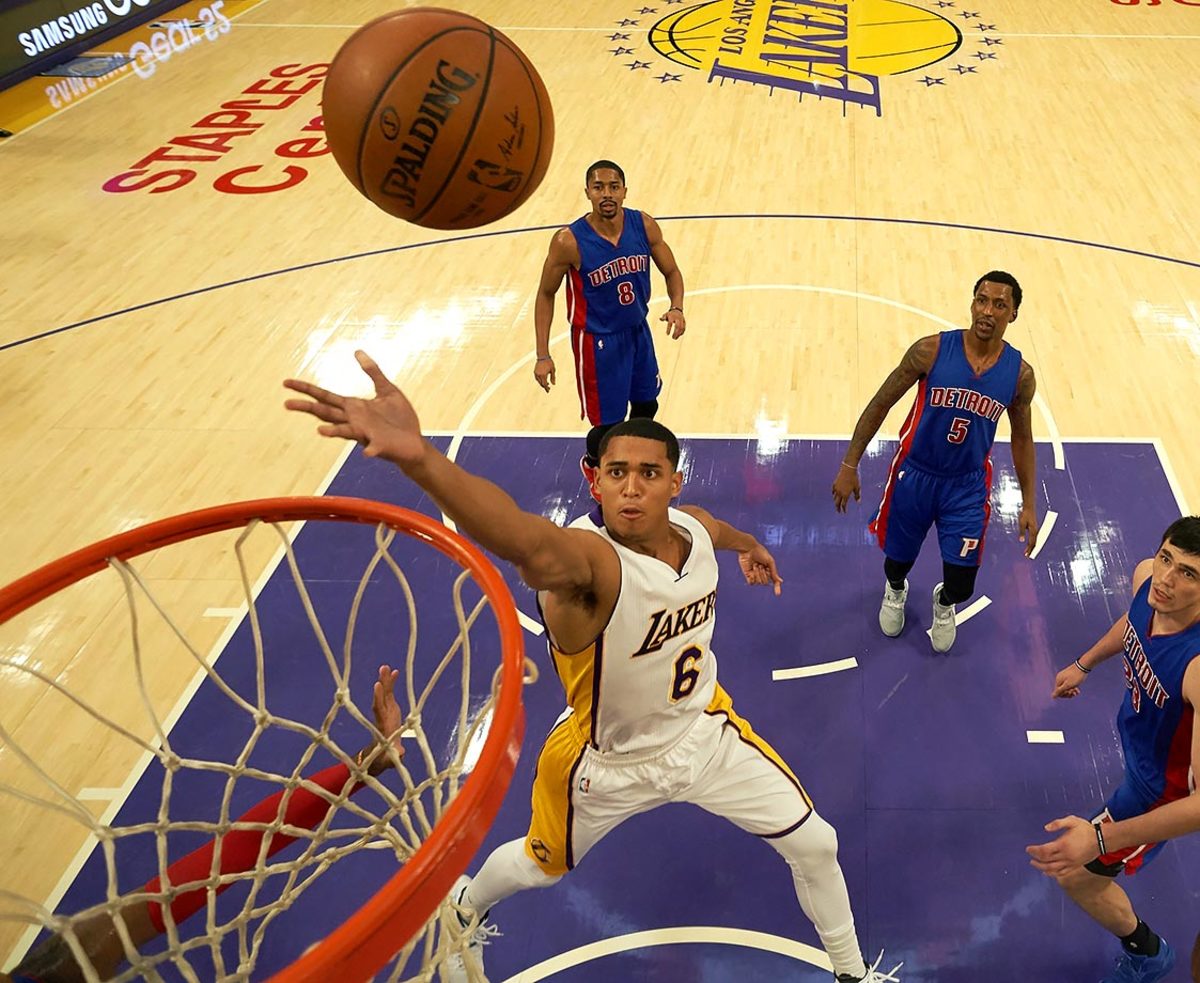
The question of how Clarkson’s talents might be best utilized really comes secondary to acknowledgement of his impressive all-around scoring game. Clarkson’s skills are rather polished for a rising NBA junior—perhaps in part due to his being 24 years old—regardless of whether he’s running the point or working alongside another playmaker. Any smart team would have him do both; Clarkson aims to score by default, but there’s enough awareness to his game to create when the situation allows.
28. Luol Deng
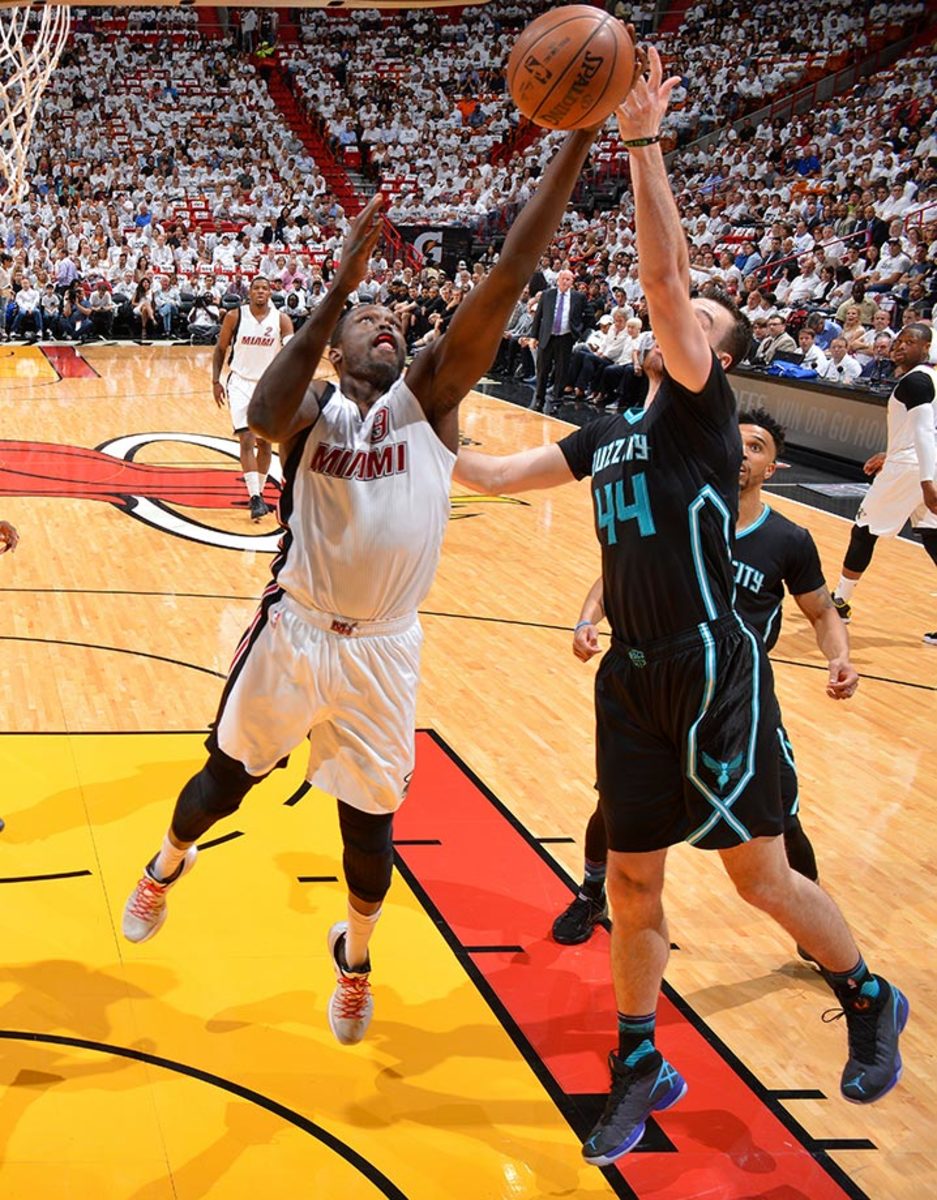
While no longer one of the NBA’s top perimeter defenders, Deng still dedicates himself to his matchup and is discerning enough to take the best angles to help his cause. Length, too, goes a long way; a 6'9" forward with a wingspan like Deng’s makes switching a more viable defensive strategy and small ball less of a size concession. Coaches appreciate that, regardless of his role, Deng knows what he’s doing; it’s not just experience that matters, but the kind of baseline knowledge that allows players to understand the goals of a particular approach and act accordingly. Many can operate to the letter of a coach’s instruction. Veterans like Deng better understand when the principles of a system should apply and how—allowing for intuitive adjustment in the thick of a possession.
29. Evan Turner
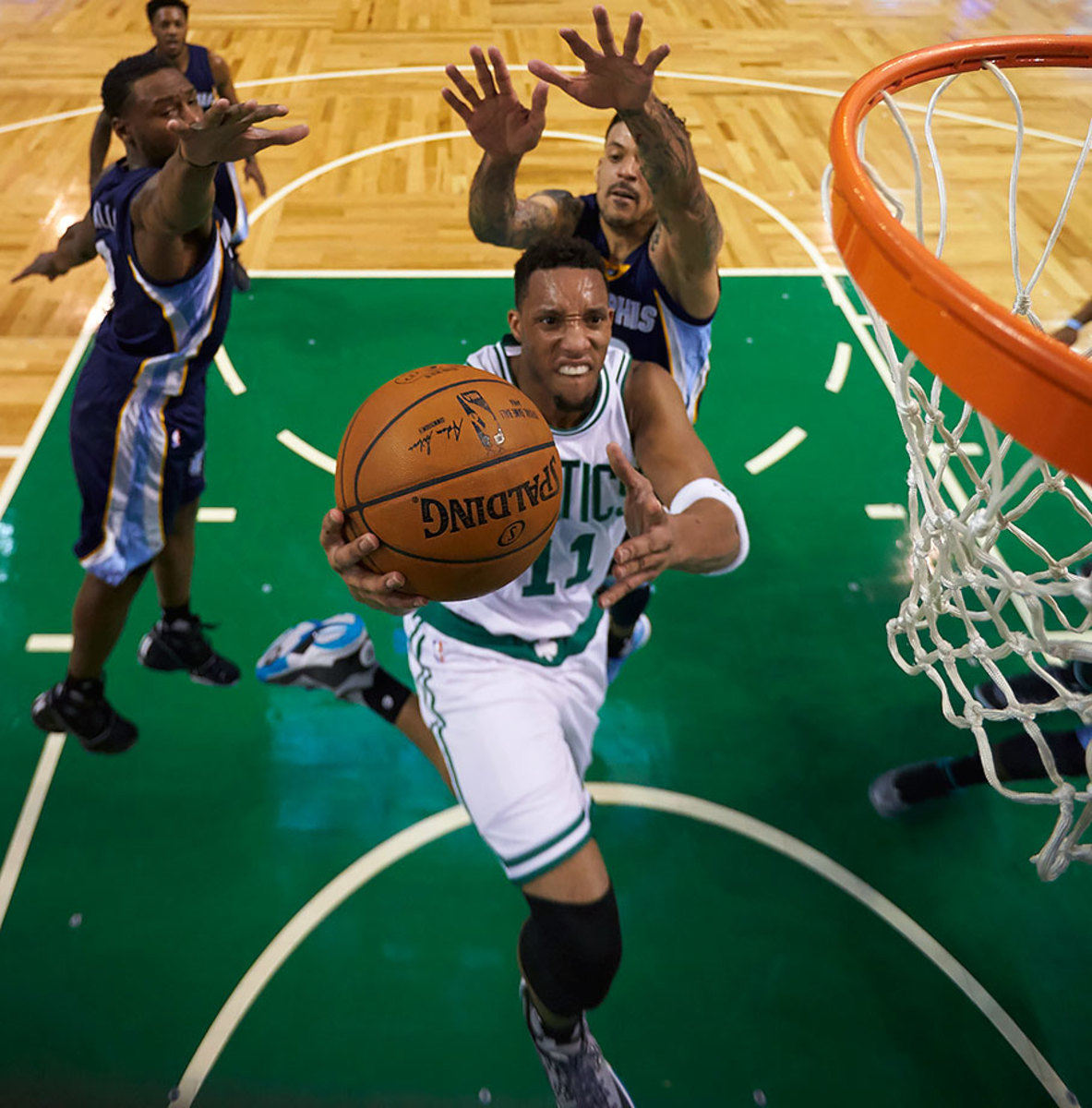
Versatility doesn’t only come into play when filling out a roster or constructing lineups. It’s a factor on every possession that goes awry, and it’s in those scenarios that Turner seems to thrive. Need a random post-up against a mismatched guard? Turner’s your guy. Need to trigger a quick pick-and-roll but the point guard is on the far side of the floor? Turner is perfect for the job. Need a wing to drive off a kick-out to keep the defense compromised before setting up an open teammate? Turner can handle the task, easy. The same goes for spot rebounding, scrambling defense, and so much more. It’s hard to define on a possession-to-possession basis what Turner might end up contributing, though on balance his wide-ranging game yielded 13.5 points, 5.7 assists, and 6.3 rebounds off the bench last season.
30. Jeremy Lin
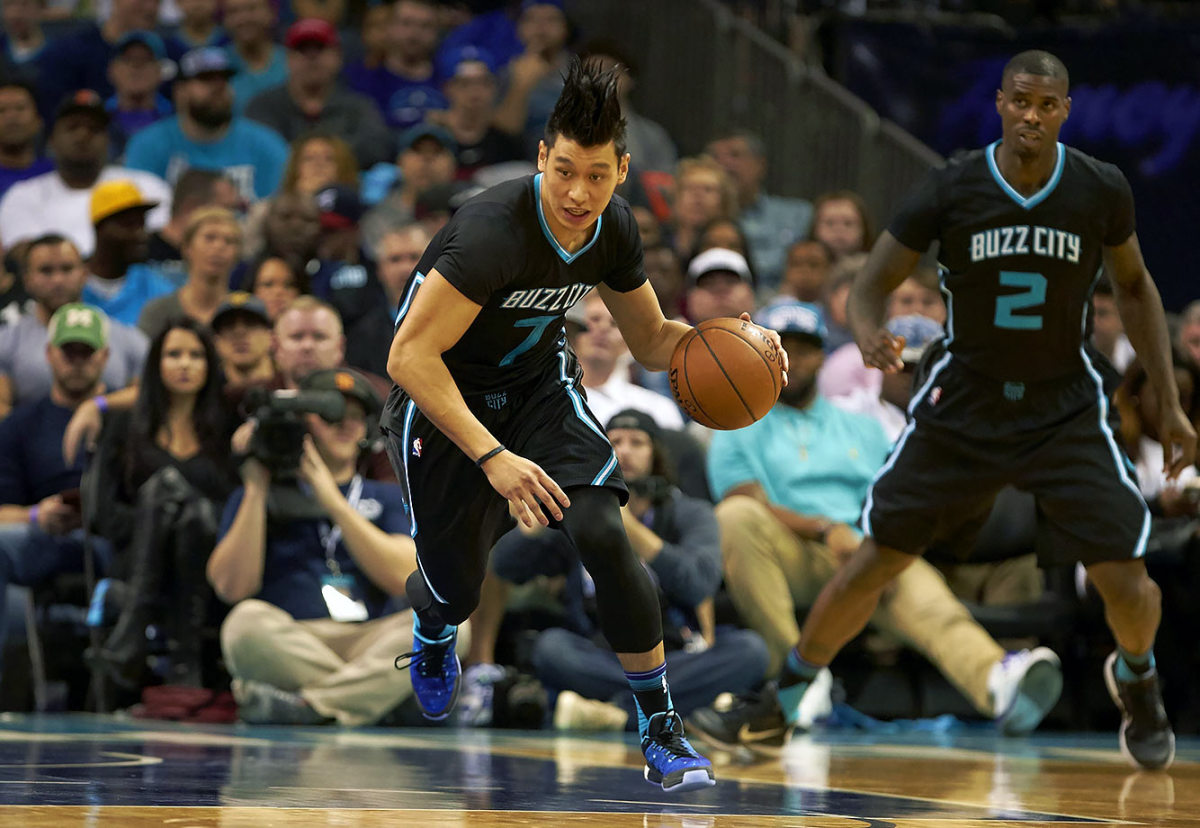
The best option on the board for teams looking to invest in a downhill driver on a reasonable budget. Lin spent the earlier days of his career pushing wildly into traffic with no discernible plan and few skill-based contingencies. The most important development of his career was his learning of what plays might be a lost cause. Fewer of Lin’s drives than ever are dead ends, leading to a career-low turnover rate. Still he looks to attack the basket out of the pick-and-roll and when kicked the ball on the weak side. Those possessions are simply less fretful now that Lin has a better understanding of when to take a mulligan and regroup the offense.
NBA and NBPA should explore equivalency clauses and cap adjustments
As we recently argued on SI.com in regard to the Los Angeles Rams, significant financial disparities caused by varying states taxes and costs of living among franchises undermine the “leveling the playing field” rationale for salary caps and maximum salaries. After all, if the Spurs and Heat, along with other teams that play in states without income taxes, can effectively offer Durant and other max players millions of dollars more than other teams, then the bidding process for players is skewed in favor of similarly-situated franchises.
One possible remedy to this imbalance would be for the NBA and NBPA to collectively bargain the inclusion of what we call “equivalency clauses” in max contracts. These clauses would adjust the monetary value of max contracts to account for state income tax and cost of living differences. There would also need to be corresponding adjustments to the league’s salary cap figure, so that teams in higher taxed states would be assigned greater cap space. These adjustments could become part of a tax-adjusted salary cap. With Durant, for example, he might earn a slightly higher salary in a max contract by signing with the Clippers or Warriors than with the Massachusetts-based Celtics, where the state income tax is lower than in California.
To be sure, the NBA and NBPA negotiating appropriate formulas for equivalency clauses and salary cap adjustments would be challenging and contentious. Such formulas would also require periodic updates to reflect any tax law changes. Yet in the absence of equivalency clauses, certain teams will have a built-in advantage to sign max players: They can offer players the opportunity to take home much more money than other teams. We’ll soon find out whether Durant is influenced by that dynamic.
Michael McCann is a legal analyst and writer for Sports Illustrated. He is also a Massachusetts attorney and the founding director of the Sports and Entertainment Law Institute at the University of New Hampshire School of Law. McCann also created and teaches the Deflategate undergraduate course at UNH. He serves on the Board of Advisors to the Harvard Law School Systemic Justice Project and is the distinguished visiting Hall of Fame Professor of Law at Mississippi College School of Law. He is also on the faculty of the Oregon Law Summer Sports Institute.
Robert Raiola is the Director of the Sports and Entertainment Group at the accounting & advisory Firm PKF O’Connor Davies. He has more than 20 years of experience in the public and private sector providing business management services, tax planning and business consulting to high net worth individuals and their families in the sports and entertainment industries.
